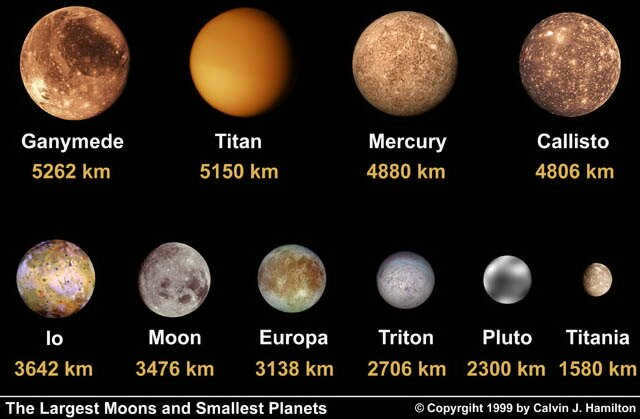Even without possessing a specialized astronomical device, one can easily comprehend the vast size disparity between Jupiter and Earth. This can be achieved by simply observing visual representations of the colossal celestial body, distinguished by its well-defined edges.


Jupiter’s size is difficult to determine due to its unique composition as a gas giant. The constantly shifting chemical elements in its atmosphere and surface, which is represented by a Global Ocean, make it impossible to pinpoint its exact dimensions.
Due to the obscuring nature of the thick clouds in the higher atmospheric layers (which appear to be the observable limits of the entity), precise determinations of the ongoing phenomena become unattainable. Consequently, all computations rely solely on research data, and the dimensions of Jupiter are assumed to be equivalent to the outline of its visible cloud boundary.
The size of this celestial entity is characterized by its radii:
These measurements hold true for Jupiter’s current position. If it were positioned closer to the Sun, its diameter would be greater as it would experience heightened solar heating, causing the gases to expand.
Due to its rapid rotation around the axis (completing a full revolution in just 10 hours), the celestial body is slightly distorted on its polar side. Jupiter’s geometric shape is known as a oblate spheroid.
In order to simplify calculations, scientists have chosen to model the gas giant as a nearly 140,000 km diameter sphere. This simplification is possible because Jupiter’s surface lacks mountains and valleys, unlike rocky celestial bodies.
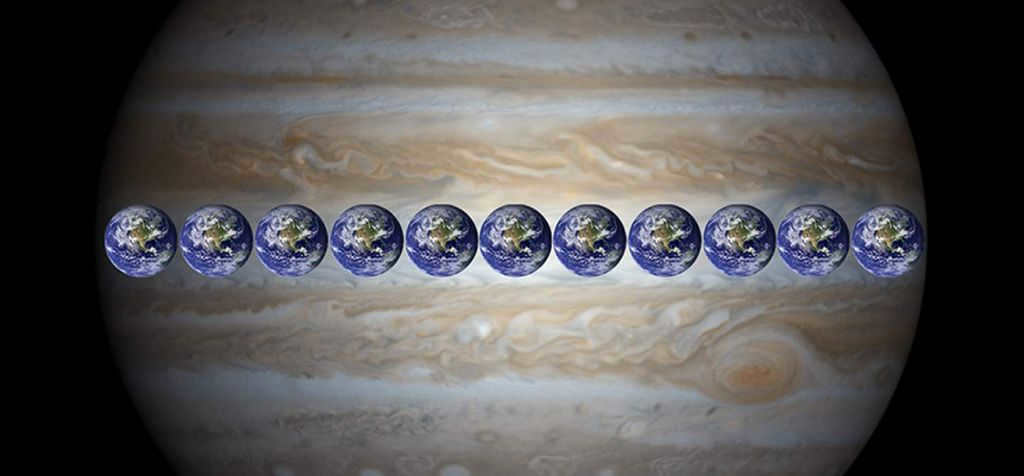
Comparing Sizes
The average diameter of Jupiter is 139,822 km, which is nearly 11 times larger than Earth’s diameter. Jupiter is well-known for its massive storm, the Great Red Spot, which has varied in size from 24,000 to 40,000 km over the years. In comparison, our planet with an average radius of 6,371 km would be completely engulfed by this atmospheric phenomenon.
If a spacecraft were to orbit Jupiter, it would need to travel more than 440,000 km. To put this into perspective, if the same spacecraft orbited the Earth along the equator, it would only cover a distance one-tenth as long.
TrES-4, an exoplanet found in the constellation Hercules, is larger than Jupiter and is at least one object in space that surpasses Jupiter in size. It is a gas giant and is 1.8 times bigger than our “giant.” However, in our solar system, Jupiter is not the largest celestial body. The Sun, which is 10 times larger in radius, takes that title.
Comparison of Volume and Area
By using a mathematical formula and knowing the diameters of Jupiter and Earth, we can compare the volume of these celestial bodies. The calculations reveal that Jupiter is approximately 1300 times larger than Earth in terms of volume.
Additionally, the formula also shows that Jupiter’s surface area is 122 times larger than Earth’s.
The weights of the planets
In terms of weight, a colossal planet is 318 times more massive than our own. It is twice as heavy as the combined weight of Pluto, Saturn, Uranus, Neptune, Mars, Earth, Venus, and Mercury. In contrast, Jupiter itself is significantly smaller than the Sun, which accounts for approximately 99.86% of the overall weight of the entire solar system.
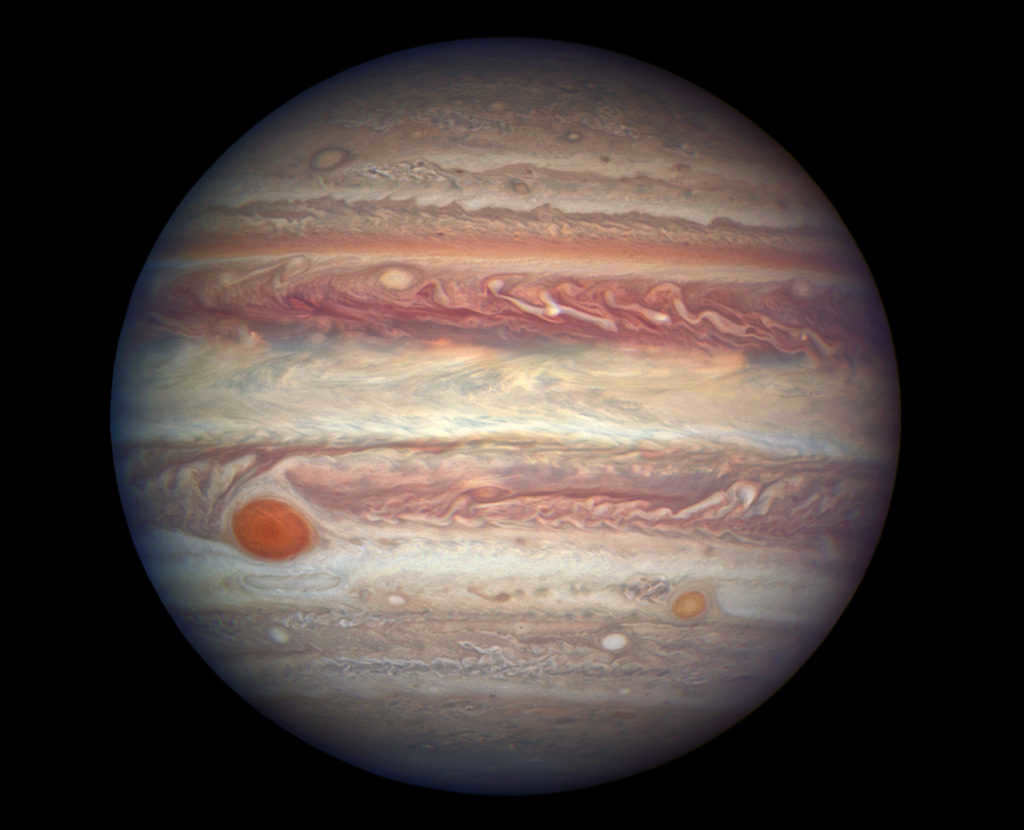

The mass of the colossal planet was theoretically calculated based on the given parameters:
Another 1% is made up of a mixture of various gases and water vapor, so the average mass of these components was used in the computations.
However, there is one physical quantity in which Jupiter did not become an absolute record-breaker – its density. In terms of this characteristic, it ranks fifth in the solar system. Despite its apparent weight, this planet is relatively “light” because it is composed not of solid rocks, but of gases.
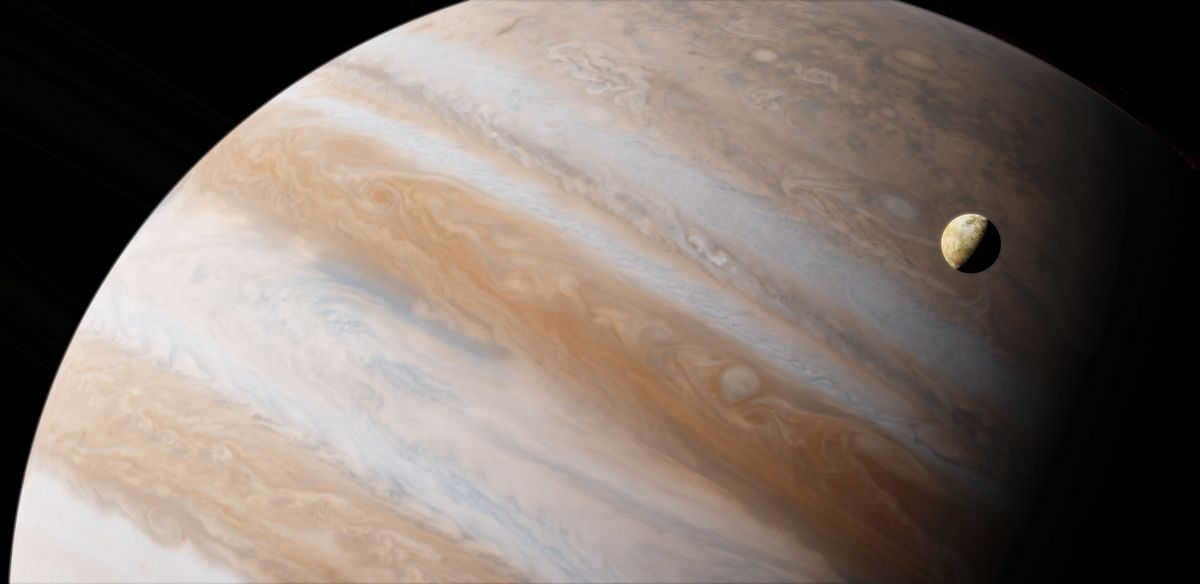
Jupiter, the largest celestial body in the solar system, is the fifth most distant planet in our stellar system. As a colossal gas giant, it is easily visible in the southern part of the sky, towering above the horizon, and has always captured the attention of astronomers.
References to this mesmerizing planet can be found in the ancient cultures of Babylon, Greece, Mesopotamia, as well as in the records of early Chinese astronomers and the ancient Incas of America.
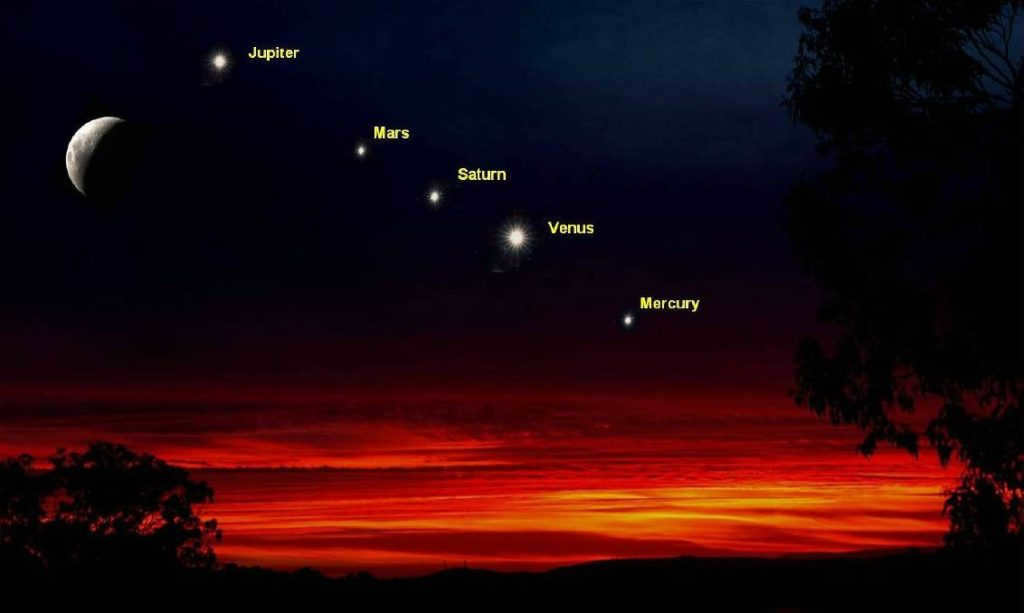
Key characteristics
The primary qualities of this colossal giant within our stellar system are its immense size and mass, with the latter being so vast that it surpasses the combined mass of all other planets in the solar system by a factor of 2.47. Additionally, its center of mass with the Sun extends beyond the star itself by 7% of the solar radius, equivalent to 0.004652 astronomical units.
Size, mass, and orbit
Jupiter, being the largest planet in our solar system, possesses several unique characteristics:
- It has a mass of 1.89861027 kg, which is equivalent to 317.8 times the mass of Earth.
- The volume of Jupiter is approximately 1,143,281015 km3, making it 1,321.3 times larger than Earth.
- Jupiter has an average density of 1.326 g/cm3, which is equivalent to 1330 kg/m3. This density places Jupiter as the second densest gas giant, with Neptune being the densest at 1760 kg/m3.
- The equatorial radius of Jupiter is approximately 71,492±4 km, which is 11.2 times larger than Earth’s radius.
- The polar radius of Jupiter is approximately 66,854±10 km.
- The mean radius of Jupiter is approximately 69,911±6 km.
- Jupiter has a rotation speed of 12.6 km/s around its equatorial axis, which is equivalent to 45,300 km/h.
- The orbital velocity of Jupiter is approximately 13.07 km/s.
- The time it takes for Jupiter to complete one full rotation on its axis relative to the stars is 9.925 hours.
- Jupiter takes 11.8618 Earth years or 4332.589 days to complete one orbit around the Sun.
- At its closest point to the Sun, Jupiter is approximately 7.40573610 8 km away.
- At its farthest point from the Sun, Jupiter is approximately 8.16520810 8 km away.
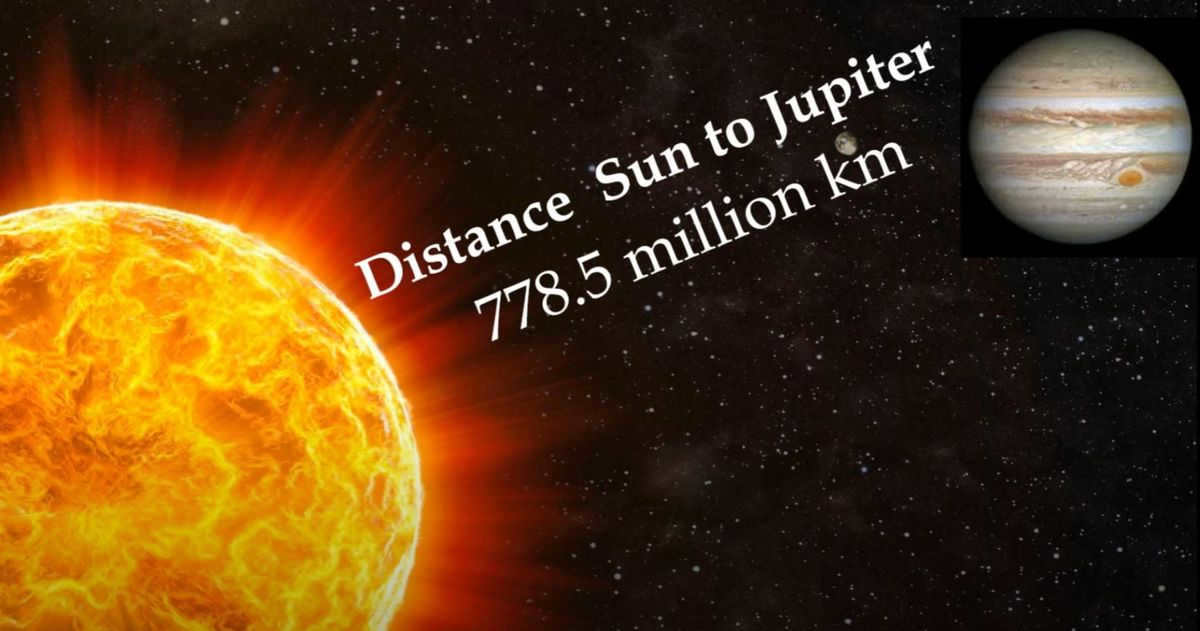
- The distance between Jupiter and Earth varies from 588 to 967 million km.
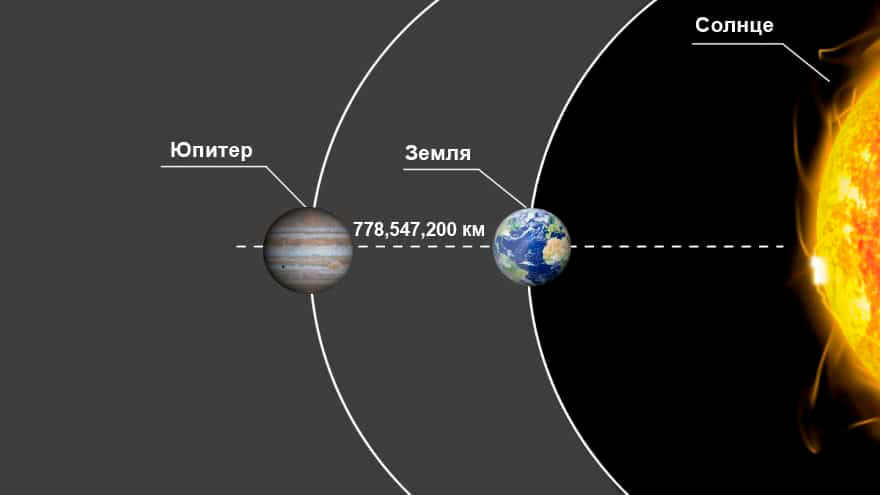
Composition and Size of Jupiter’s Atmosphere
There is no doubt that Jupiter possesses a substantial atmosphere, as it is classified as a gas giant. The term “atmosphere” refers to the gaseous shell surrounding a celestial body, and Jupiter’s gas envelope is the largest in the entire solar system.
Through the exploration conducted by the Galileo spacecraft, which embarked on its mission on December 7, 1995, scientists have gained insight into the composition of Jupiter’s atmosphere:
- Approximately 90% of the atmosphere is composed of hydrogen.
- Up to 10% of the atmosphere consists of helium.
- In addition, trace amounts of other chemical elements such as ammonia, benzene, water, methane, hydrogen sulfide, and phosphine have been detected.
The planet’s atmosphere does not have a lower boundary due to the presence of liquid hydrogen below it. Nevertheless, it can be divided into different layers when observed from top to bottom, including the exosphere, thermosphere, stratosphere, and troposphere.
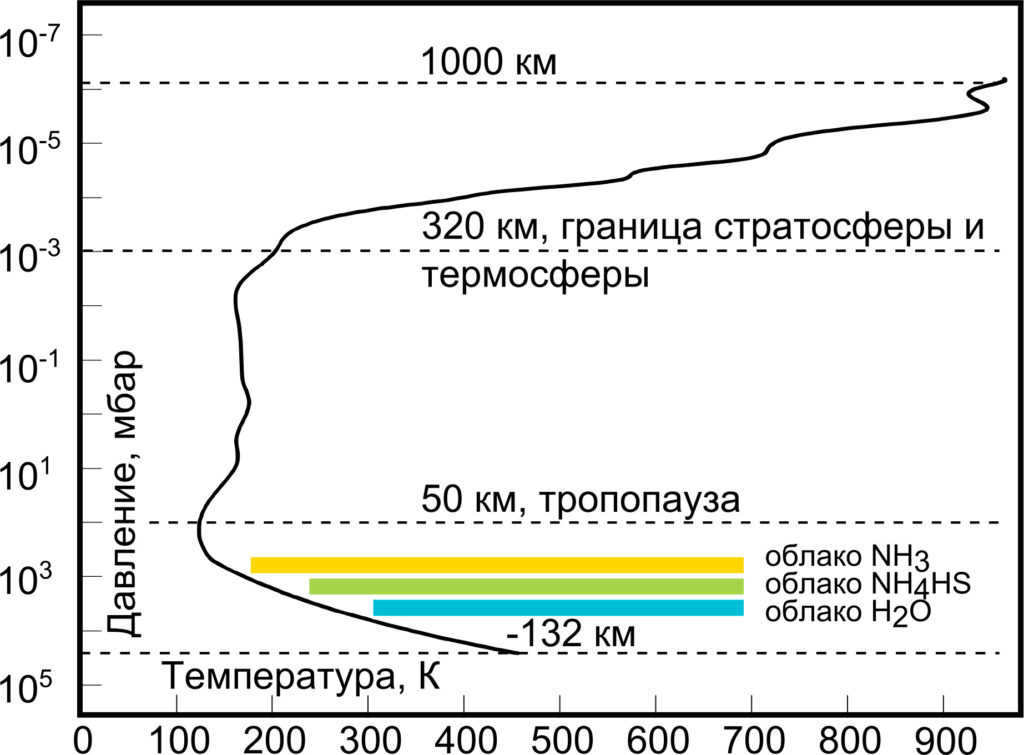
The temperature on Jupiter throughout the day and night is as follows:
Composition and Surface
The planet’s surface is 122 times larger than that of Earth, so the question of whether Jupiter has a solid surface elicits only a slight chuckle from those who are knowledgeable about the topic. The planet’s matter is composed of gaseous and liquid forms that contain small amounts of ammonia, hydrogen sulfide, methane, and water. Any doubts about the existence of a solid surface on Jupiter can be resolved with a negative answer, unless we take into consideration the potential rocky structure of the planet’s core.
Composition
Considering the gas giant’s hydrodynamic and thermodynamic equilibrium, as well as analyzing observational data, we can make assumptions about the makeup of planet Jupiter:
- The planet is primarily composed of an atmosphere, which is responsible for the formation of clouds consisting of frozen ammonia and ammonium hydrosulfate crystals in the lower layers. Directly below these clouds, there exists water in the form of liquid or ice.
- Deeper within the planet lies a layer of metallic hydrogen.
- Beneath the layer of metallic hydrogen lies a rocky core, which answers the question of whether Jupiter possesses a solid surface.
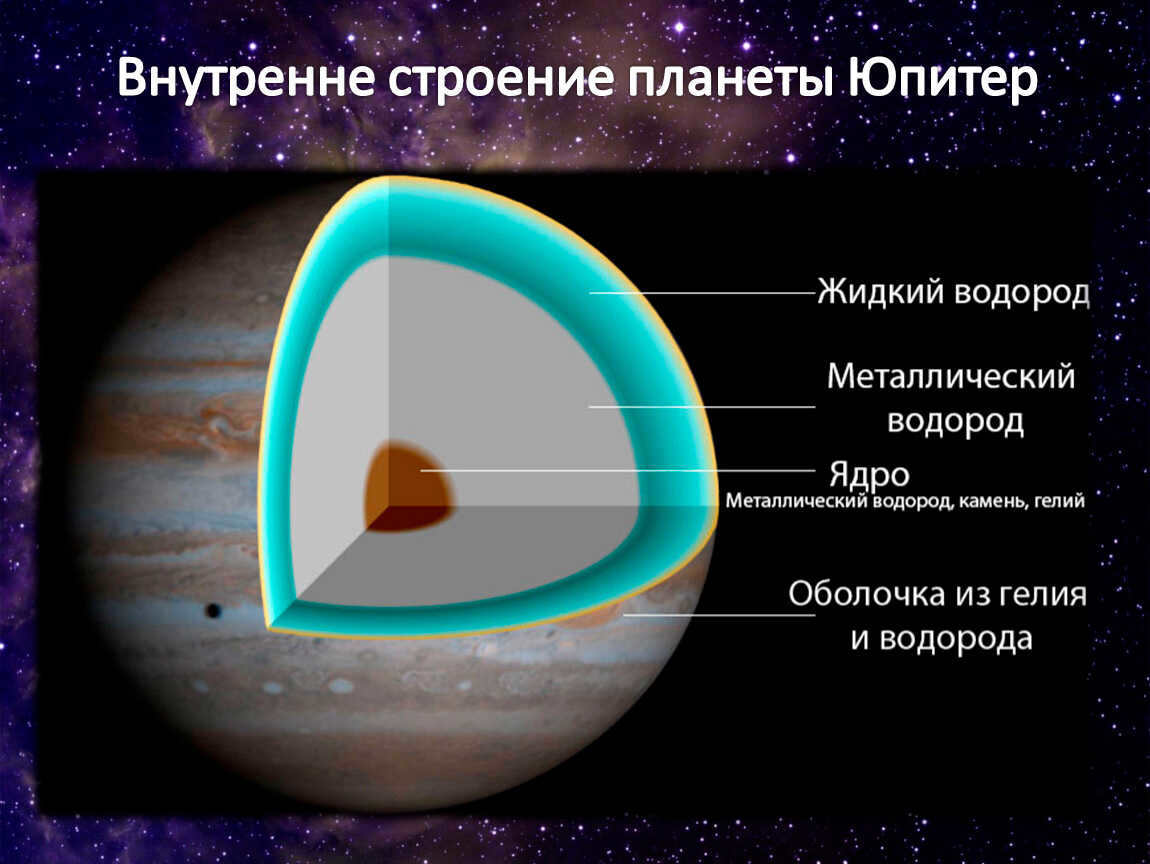
Jupiter’s Moons and Rings
When observing Jupiter through a telescope from Earth, it becomes apparent that the planet is not solitary, but rather accompanied by an entourage of moons and rings. With a total of 79 moons, Jupiter holds the second position in our solar system. These moons are categorized into two groups: inner and outer.
Exterior moons
Referred to as such because of their considerable distance from the planet, these celestial entities lack substantial mass. Among the 71 moons in total, we can only single out Himalya, which measures approximately 170 km in size.
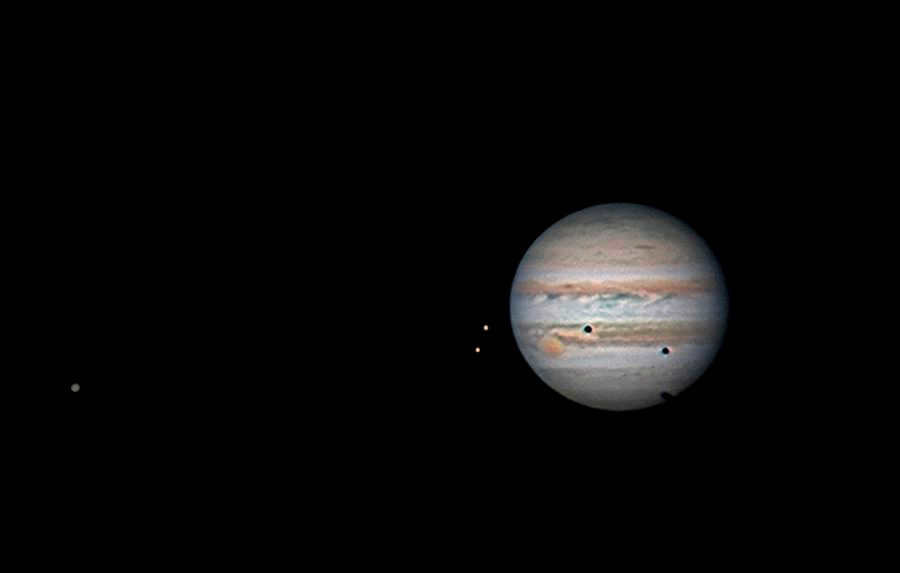

Moons close to Jupiter
The inner moons of Jupiter are even more fascinating as they are the largest in the entire solar system. The first set of these moons – Io, Europa, Ganymede, and Callisto – were discovered by Galileo Galilei in 1610. The second set, known as the Amalthea group, consists of four smaller moons with diameters of up to 250 km. This group includes Metida, Adrastea, Amalthea itself, and Teba.
Jupiter’s Rings
In 1960, Soviet astronomer Sergei Vsekhsvyatsky had no doubts about the existence of rings around Jupiter.
At that time, he proposed a scientific hypothesis regarding the presence of these rings, and it was later confirmed by a study conducted by the American space probe Voyager 1 in 1979.
Jupiter’s rings are composed of dust particles resulting from satellite collisions. They can be divided into four main components:
- The thick and dusty halo ring,
- The thin but bright Main Ring,
- The two outer rings, known as the “spider rings,” which are transparent and thin.
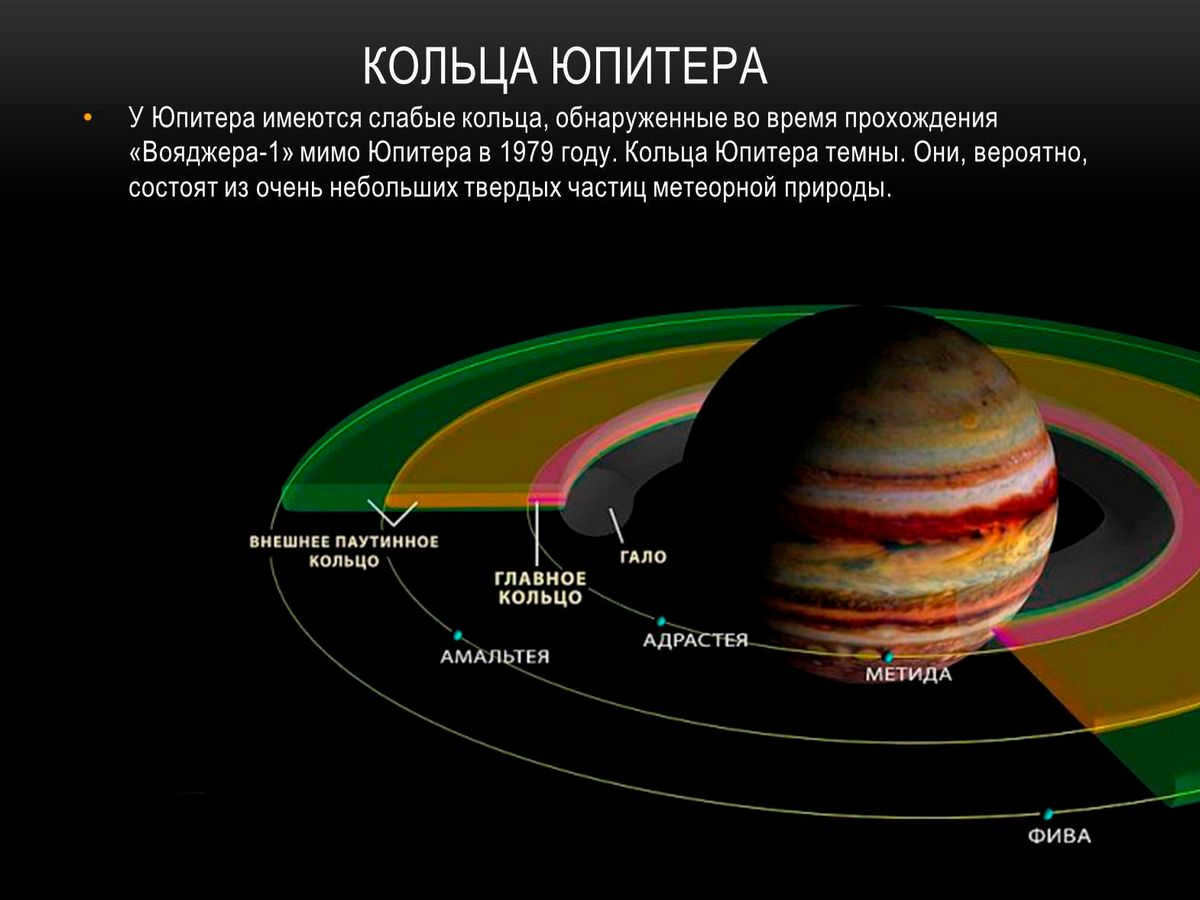

The Great Red Spot of Jupiter
Anyone who has a fascination with the study of celestial objects is undoubtedly familiar with the celestial body that is home to the Great Red Spot. This particular feature has, in fact, become synonymous with Jupiter, serving as its distinctive trademark.
What is the Great Red Spot?
The Great Red Spot is simply a cyclonic storm – a storm or hurricane that rages in the atmosphere of Jupiter’s southern hemisphere. This fascinating phenomenon, which is over 400 years old and spans 40,000 km, was discovered by the Italian-French astronomer Giovanni Cassini in 1665. As time has passed, the size of the spot has gradually decreased. Scientists hypothesize that by the year 2040, it will become a perfect circle in shape.
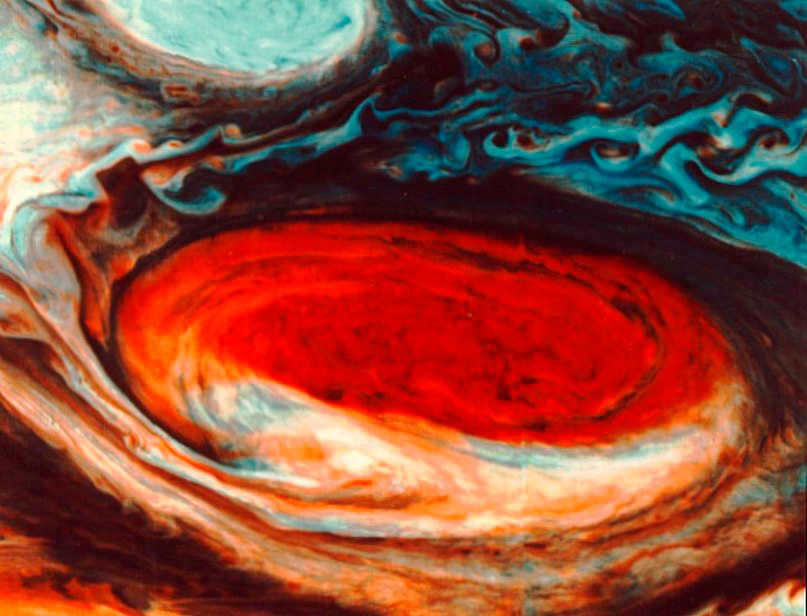

The Small Crimson Spot
Another cyclonic storm on Jupiter, known as the “Small Crimson Spot” or “Oval,” formed in the year 2000 through the combination of two initial vortices and later a third one. It has been steadily increasing in size ever since. In 2006, the two spots collided with each other, but managed to separate without any noticeable impact on one another.
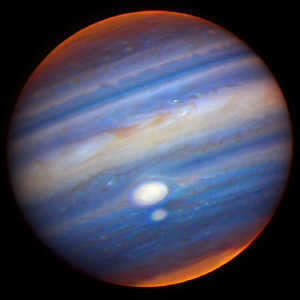
Jupiter’s BKP Rotation
Jupiter’s BKP undergoes a complete counterclockwise rotation around its own axis every 6 Earth days, constantly moving both eastward and westward. While the speed of the spot’s movement has varied over time, it has never ceased. This may be due to the lack of friction on Jupiter’s solid surface, which would otherwise impede the rotation of such a large storm.
The storm’s edges exhibit an intriguing feature, rising 8 km above the rest of the mass and experiencing winds blowing at speeds of up to 432 km/hour.
The BKP’s Color
The color of the BKP, including both the big red spot and the small one, remains one of the great mysteries that has yet to be solved. There are several theories as to why the spots have their distinct colors:
- One possibility is the presence of organic molecules, such as phosphorus red or complex sulfur compounds.
- Another theory suggests that the color change is caused by the interaction between sunlight and the acidic ammonium salt found in the clouds surrounding both spots.
Observations have shown that the color of the spots is highly variable and can change frequently, ranging from different shades of red to white.
Observation of Jupiter
Ancient Babylonian manuscripts, dating back to the 7th and 8th centuries BC, contain the earliest records of observations of Jupiter.
The credit for the discovery of Jupiter can only be given to our ancestors, as it is relatively easy to spot in the sky.
In 1609-1610, the German astronomer Simon Marius and the Italian Galileo Galilei independently conducted more extensive investigations using telescopes. These efforts led to the discovery of Jupiter’s first and largest satellites, which became known as Galileo Galilei’s satellites.
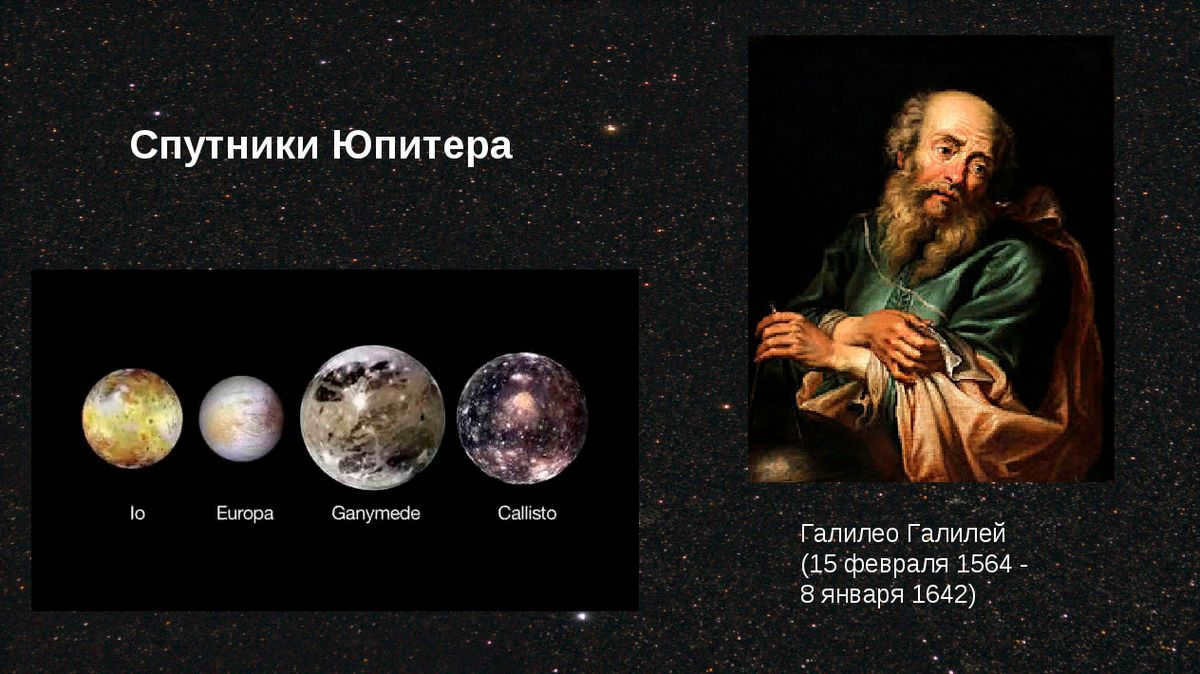
In addition, more in-depth examination of Jupiter was associated with the analysis of the planet’s emission of electromagnetic waves in the infrared and short-wave spectra, as well as with radio observations and investigations carried out by spacecraft. By 2018, a total of 2 orbital missions and 7 flyby missions have been successfully completed.
- “Pioneer-10” – 1973.
- “Pioneer 11 – 1974.
- “Voyager-1” and “Voyager-2” – 1979.
- “Ulysses, 1992 and 2000.
- “Cassini – 2000.
- “New Horizons – 2007.
- “Galileo orbited Jupiter from 1995 to 2003.
- “Juno” has been in orbit since 2016.
It enabled the detection of massive lightning in the heart of the Lesser Red Spot, the observation of scorching shadows from satellites, and the exploration of Jupiter’s magnetosphere, which generates continuous auroras at both its poles.
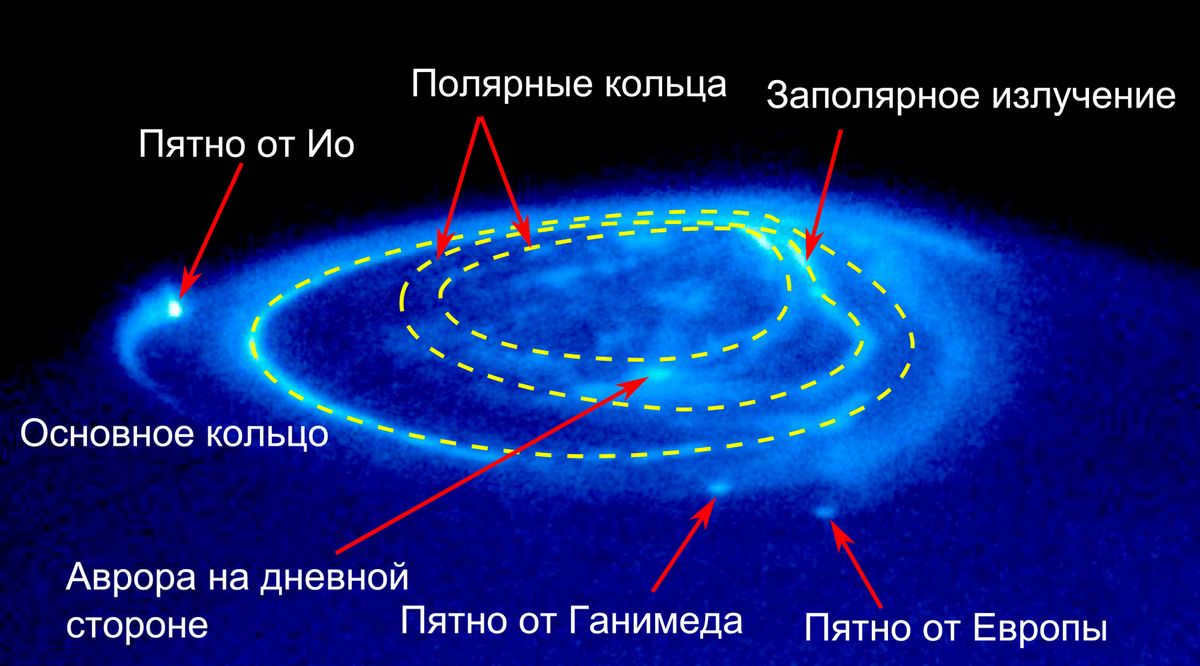
Finding Jupiter in the Sky
Locating Jupiter in the night sky is a simple task on a clear night. In this case, there is no need to determine Jupiter’s position in relation to the Sun. With its impressive brightness, Jupiter is only surpassed by the Moon and Venus. The best times to observe Jupiter are during the winter oppositions or when the planet is at its closest proximity to Earth.
An opposition occurs approximately every 13 months, when Jupiter is nearest to Earth. A much rarer occurrence is the Great Confrontation, which happens approximately every 13 years. During this event, both planets are not only at their closest distance, but Jupiter is also at its closest point in its orbit. Any reputable astronomer would not want to miss such a remarkable event.
Study History
Efforts to understand Jupiter’s nature and behavior have a long history, with some notable early contributions:
- Ancient Chinese scientists were among the first to study Jupiter, meticulously documenting its 12-year orbital cycle.
- Claudius Ptolemy, an astronomer from Alexandria, Egypt, and the architect of the geocentric world system, made significant strides in studying Jupiter. He calculated the planet’s revolution around the Earth to last approximately 4332.38 days. Later, in 499, the Indian astronomer and mathematician Aryabhata refined this calculation to 4332.2722 days.
Copernicus and the heliocentric model of the universe
However, the geocentric system was based on an unexplained contradiction – the retrograde motion of the planets, where they would appear to move in a direct motion and then reverse, which could not be reasonably explained.
Nicolaus Copernicus, a Polish astronomer, challenged the geocentric system by proposing the heliocentric model of the universe, which placed the Sun at the center instead of the Earth. This revolutionary idea overturned the established beliefs of Ptolemy and his followers. With this new perspective, everything started to make sense, including the positioning of Jupiter as the fifth planet when counting from the Sun.
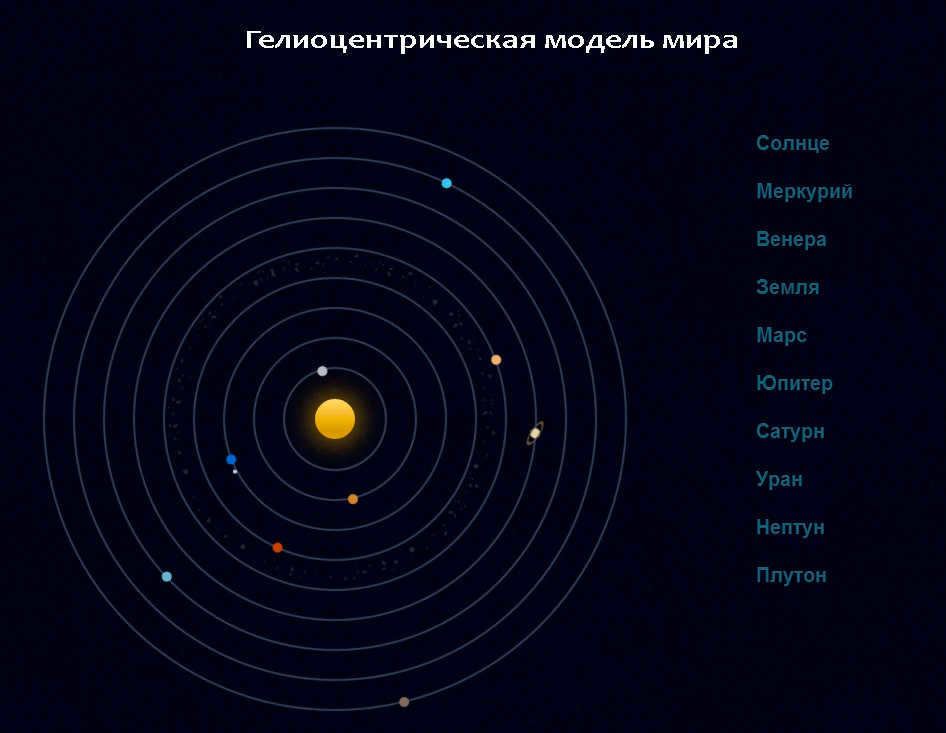
Exploration of Jupiter
It is impossible to determine the first individual to have spotted Jupiter in the sky, as it is clearly visible to the naked eye. However, Galileo Galilei is credited as the first person to observe the planet through a telescope and report the presence of stripes on its surface. He was also able to observe four of Jupiter’s largest satellites using his telescope. This discovery provided strong evidence in support of the heliocentric model of the solar system.
Jupiter’s Influence on Culture
Throughout history, the magnificent presence of the planet Jupiter has inspired a sense of awe and reverence among ancient civilizations. Various cultures have associated Jupiter with their own gods and deities, attributing different qualities and powers to this celestial body. For instance, in Chinese mythology, Jupiter was linked to the god Tai-Sui, while in Semitic mythology, it represented the deity Gada, who was believed to bring success and good luck. The Babylonians regarded Jupiter as the head of their pantheon of gods, with Marduk being its corresponding deity. In Hinduism, devotees would undertake pilgrimages to sacred shrines during the religious festival known as Kumbha-mela to honor Jupiter and seek its blessings.
Zeus, the supreme deity in Greek mythology, is equivalent to Jupiter – the ruler of the sky, thunder, and lightning. Jupiter is often symbolized by the majestic eagle, which represents his power. In Norse mythology, Jupiter is associated with Thor, one of the gods of the Aesir. Across various Indo-European cultures, Jupiter is revered as the god of thunder, and his day of the week is Thursday, named after him in different languages.
An intriguing phenomenon is the deep astronomical knowledge possessed by the Dogon tribe in Africa. They possess information about Jupiter and its four satellites, even though these satellites are not visible without the use of a telescope. This remarkable knowledge cannot be easily explained by logical science.

Jupiter is a significant representation of astrology, symbolizing potency, influence, accomplishment, wealth, and fortune. Moreover, the planet is depicted in various forms of artistic expression, including literature, films, visual arts, and a collection of renowned and well-liked comic books.
Etymology of the planet’s name
The planet derives its name from the Roman god of gods.
In Roman mythology.
Jupiter, the central deity of the Capitoline triad, is the god after whom the planet Jupiter is named. Occupying a place of great honor alongside Minerva and Juno, Jupiter was the primary official deity of ancient Rome for many centuries, until Christianity replaced paganism.
The Roman consuls swore their oaths of office to Jupiter. The god Jupiter was highly revered and worshipped, with lavish offerings made to win the favor of the thunderer, who was often depicted as a bull with gilded horns.

How the planets get their names
Assigning the names of ancient Greek or Roman gods to planets and other celestial objects is a long-standing tradition. This practice is a clear reflection of the mythological figures that Jupiter and the other planets are named after. The rest of the planets in our solar system are also named after various Greco-Roman gods:
- The planet Mercury is named after the god of commerce and business.
- Venus is associated with the goddess of love and happiness.
- Mars is named after the god of war.
- Saturn is connected to the god of time.
- Uranus is the father of Saturn.
- Neptune is the god of water.
- Pluto is the ruler of the underworld.

The only exception to this rule was Earth, which was named after what lies beneath our feet.
Why Jupiter is not a star
Jupiter is often referred to as a failed star because it contains a high amount of hydrogen and helium. However, there are two clear reasons why it is not a star.
Firstly, to ignite hydrogen, a significant amount of oxygen is required, which is not present on the planet in large quantities. The concerns of some individuals regarding the combustion of the Galileo spacecraft, which spent 8 years studying Jupiter, turned out to be unfounded. The plutonium thermal reactor on board did not ignite the hydrogen or initiate a chain of thermonuclear reactions.
Additionally, in order for Jupiter to transform into a star, it would require a mass that is 80 times greater. In fact, if we were to combine all the matter in the entire solar system, excluding the Sun, it still wouldn’t be enough to reach this threshold, even if Jupiter were to absorb all the planets, their satellites, and asteroids. This is precisely why Jupiter has never undergone this transformation and it is improbable that it will ever do so in the future.
The Kelvin-Helmholtz mechanism: an explanation of how celestial bodies generate their own heat
The Kelvin-Helmholtz mechanism, named after the scientists who discovered it, refers to the process by which a celestial body is able to produce heat internally, surpassing the amount it receives from external sources, such as the Sun.


Jupiter, along with Saturn and brown dwarfs, experiences a process that is characterized by the supercooling of the planet. This supercooling leads to compression and subsequently heats up the inner core. However, Jupiter does not have enough mass to sustain stable thermonuclear reactions.
If Jupiter were to transform into a star, it would appear as a bright red object in the sky, shining 80 times brighter than the full Moon. However, this transformation would not have any significant thermal or gravitational effects on Earth.
Curious information
Undoubtedly, Jupiter, a planet that continues to attract attention with its interesting facts (due to its size and mass), continues to intrigue researchers who seek to obtain accurate and reliable information about this colossal celestial body.
Despite the continuous missions and ongoing research conducted by astronomers from numerous countries across the globe, there are still many unanswered questions and unexplained phenomena surrounding Jupiter. This enigmatic planet harbors countless mysteries, although some have been unraveled.
Here are some facts that shed light on the truth about this captivating planet:
- Jupiter possesses an enormous mass, 318 times that of Earth. In fact, its mass is 2.5 times greater than the combined mass of the entire Solar System, excluding the Sun itself!
- It boasts a colossal volume capable of accommodating 1800 volumes of our own planet.
- Jupiter’s gravity is 2.5 times stronger than Earth’s gravity, providing protection against potentially dangerous objects from the Oort Cloud that could gain significant velocity when striking our planet. However, for space objects originating from the asteroid belt between Mars and Jupiter, as well as comets with short orbital periods, the situation may be different. Jupiter actually accelerates them towards Earth.
- Remarkable collisions with celestial bodies have afforded us the unique opportunity to witness the fragmentation of the nucleus of comet Shumeikorov-Levy 9 (D/1993 F2) into 21 separate pieces. This event represents the first-ever observation of such a phenomenon within our solar system!
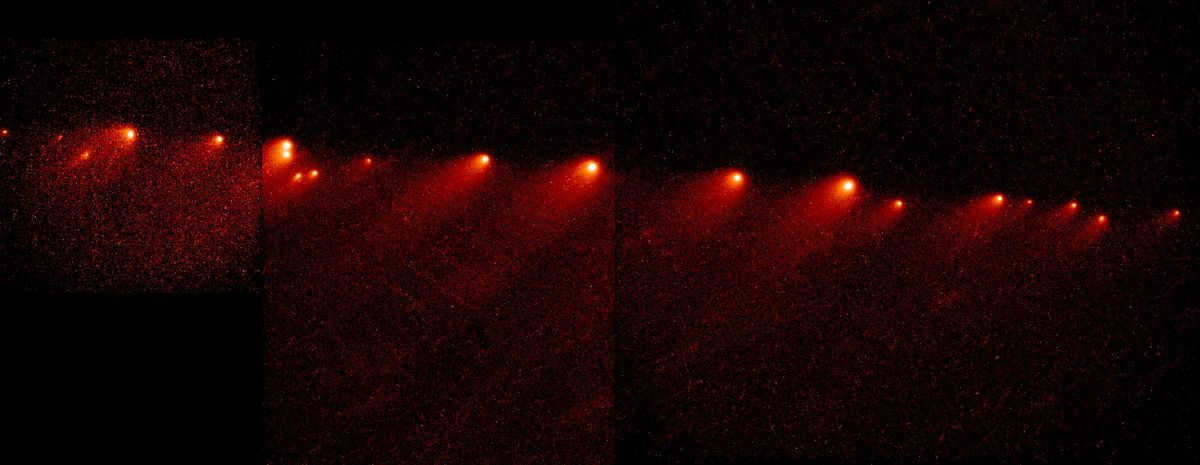
- The planet emits heat that surpasses the amount of heat energy it receives from the Sun.
- Jupiter’s core temperature reaches a scorching 20,000 degrees Celsius.
- The classification of a failed star is unlikely to be contested or reevaluated. This is because the necessary mass to initiate thermonuclear reactions is simply not present within the solar system. In fact, it would require 80 times more mass than that of Jupiter itself.
- Jupiter’s unique rotation rate allows it to complete a full revolution in less than 10 hours, making it unlike any other planet in the Sun’s star system. This rapid rotation has caused the planet to flatten at its poles and generate a powerful magnetic field, resulting in a difference of 4600 kilometers in radius between the equator and poles.
- Jupiter’s atmosphere is composed of light clouds at the bottom and dark clouds at the top. These clouds, which are only 50 kilometers thick, consist of arrays of ammonia crystals and sit above a mixture of hydrogen and helium.
- Notable atmospheric phenomena on Jupiter include winds blowing at speeds of 600 kilometers per hour.
- Periodically, the position, width, rotation speed, brightness, and turbulence of alternating light and dark stripes change in cycles.
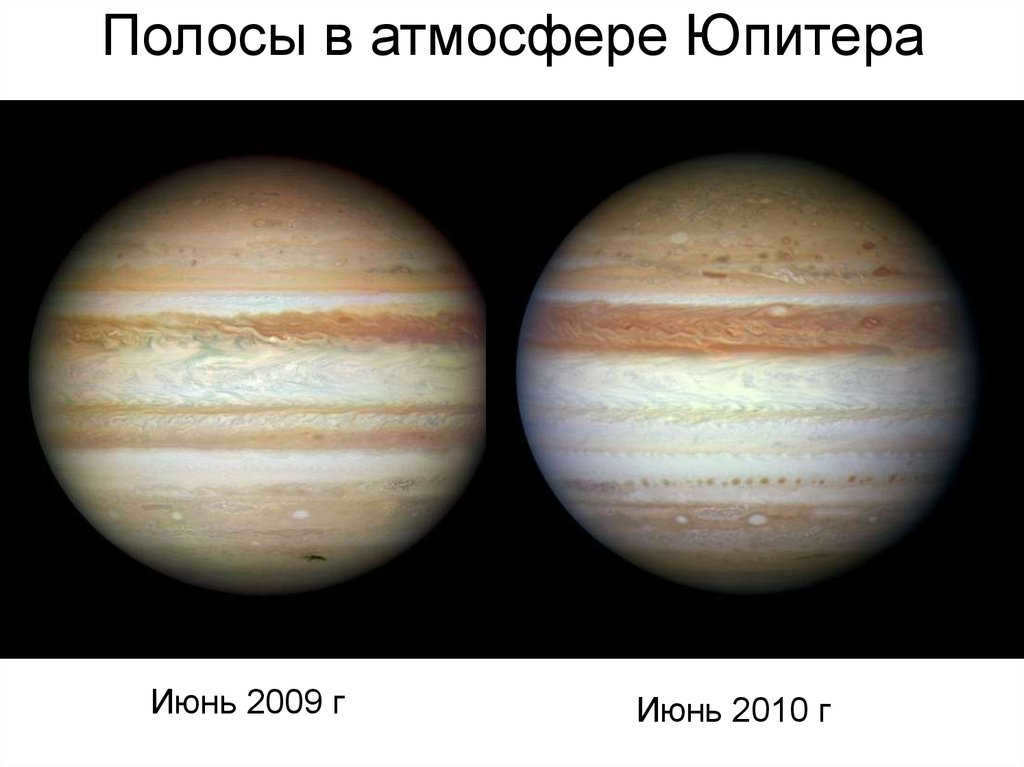
- In 1665, Giovanni Cassini discovered the Great Red Spot, which has since decreased in size from 40,000 kilometers to 20,000 kilometers.
- The Small Red Spot formed between 1998 and 2000 through the merger of three vortices.
- Jupiter experiences thousand-kilometer lightning bolts that are 1,000 times more powerful than those on Earth.
- The planet’s companion satellites create heated shadows.
- Jupiter’s rings are the result of collisions between satellites and comets or meteorites.
- Jupiter has a total of 79 satellites, and there may be even more.
- Some of these satellites are incredibly large, such as Ganymede, which has a diameter of 5260 km, surpassing the diameters of both Mercury and the Moon. On the other hand, some satellites are only a few kilometers across.
- Interestingly, there is a peculiar pattern among the outer satellites of Jupiter. The satellites whose names end with the letter “e” – Ananke, Karme, Pasiphae, Sinope – rotate in a retrograde motion, opposite to the planet’s rotation.
- In the 1970s, Carl Sagan proposed a hypothesis suggesting the possibility of ammoniacal life forms existing in the upper atmosphere of Jupiter.
Questions and Answers
Given all of the aforementioned information, there are several intriguing queries that necessitate a professional response.
Does life exist on the planet?
While highly improbable, it would be unwise to completely dismiss this possibility. Jupiter consists primarily of a gaseous blend of hydrogen and helium, lacking water and a solid surface aside from its intensely hot core, which reaches temperatures of up to 20,000 degrees Celsius. The upper atmosphere is characterized by high pressure, radiation, and extreme sunlight, all of which contribute to drastic climatic fluctuations.
Under these circumstances, the survival of any potential life forms on the planet would be greatly threatened. Consequently, it would be misguided to harbor any illusions regarding their presence.
Another point to consider is the satellites orbiting Jupiter, which contain vast amounts of water and offer much more favorable conditions. However, this theory needs to be further investigated through a series of meticulous studies.
Radiation Levels on Jupiter
Jupiter itself is not inherently radioactive. After all, how could a gas giant possess radiation? However, due to its incredibly powerful magnetosphere, it attracts cosmic radiation, resulting in the formation of intense radiation belts around the planet. The existence of these belts was first discovered in 1955 through the detection of radio waves.
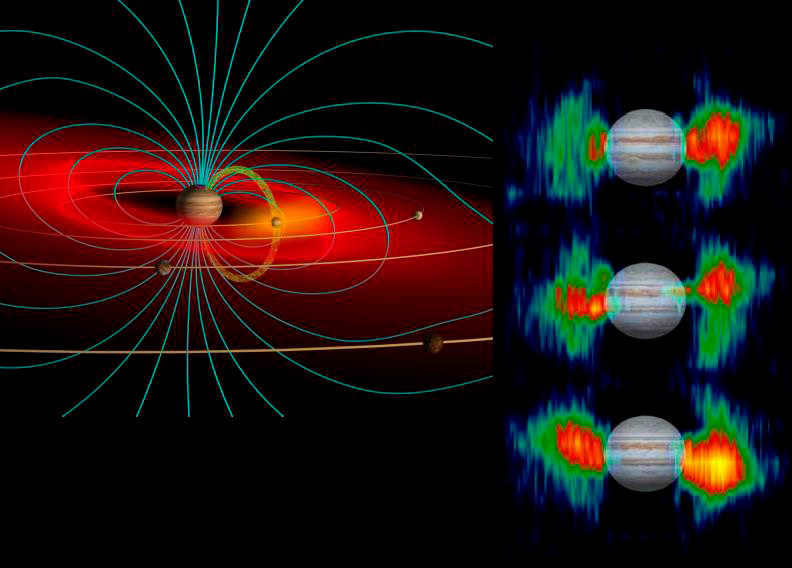
Confirmation of this fact came later with the approach of the spacecraft “Galileo” to Jupiter, which was subjected to radiation exceeding the lethal dose for humans by 25 times. This complicates the study of the planet due to the potential damage to radio-electronic equipment from the radioactive radiation. Additionally, the ionosphere layer extends up to 3000 km in length.
Therefore, future missions to Jupiter need to account for this danger and implement measures to mitigate it.
How Far is Jupiter from the Sun?
Jupiter, the fifth planet from the Sun in our solar system, has an orbital period of 11.8618 Earth years. Its orbit is significantly farther from the Sun compared to Earth’s orbit and is shaped like an ellipse, although it is not very different from a circle. As a result:
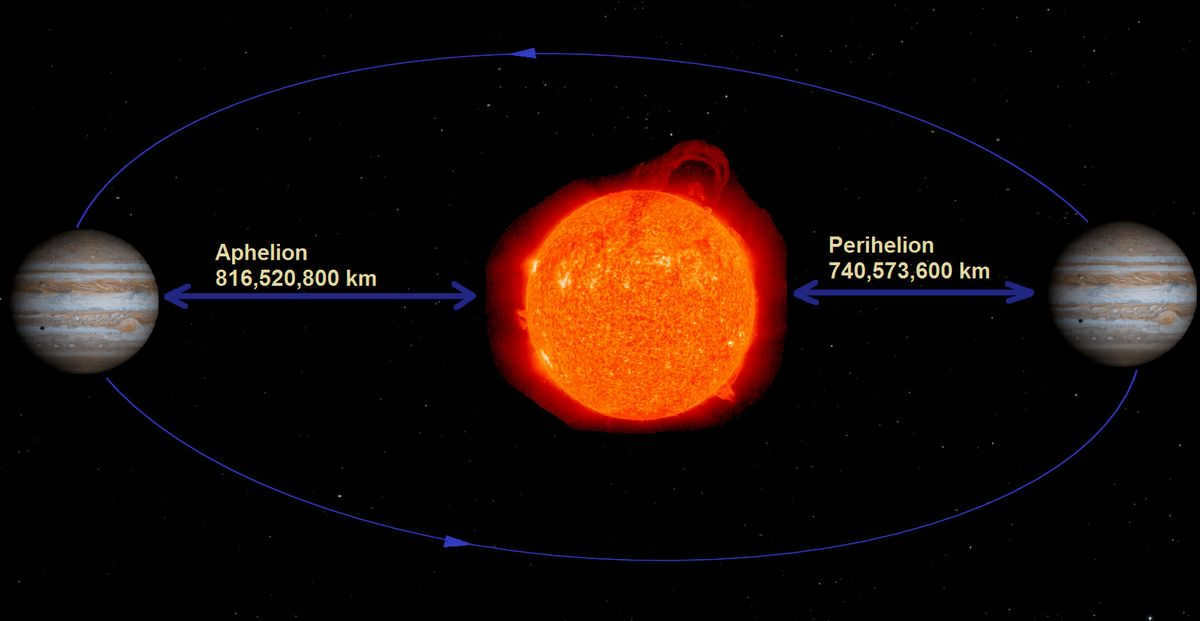
- The farthest point that Jupiter reaches in its orbit around the Sun is approximately 816.5 million kilometers or 5.458 astronomical units (a.u.).
- On average, Jupiter is about 778.5 million kilometers (5.204 a.u.) away from the Sun.
- The closest distance between Jupiter and the Sun is around 740.6 million kilometers (4.950 a.u.).
Duration of a Year on Jupiter
The length of a year on Jupiter is equivalent to approximately 12 Earth years. This means that it takes Jupiter about 12 Earth years to complete one orbit around the Sun.
In terms of Earth days, a year on Jupiter is equal to 4332.59 Earth days. However, due to Jupiter’s rapid rotation, which completes one revolution in just 9 hours, 55 minutes, and 30 seconds, a Jupiterian day is much shorter than an Earth day. Therefore, in terms of Jupiterian days, the duration of a year on Jupiter is approximately 10475.8 Jupiterian days.
Unlike the Earth, Jupiter experiences very long seasons, with each season lasting approximately 3 Earth years. However, these seasons are not characterized by significant changes in temperature and weather, as Jupiter’s gas composition differs from that of the Earth-group planets.
A potential future
The largest planet in our solar system consistently emits powerful radio waves into outer space. These signals can be picked up by amateur receivers with short-wave antennas. The audio characteristics of the received signal from Jupiter are quite unique and may be mistaken by some for a communication from extraterrestrial beings.
However, for those with a more realistic perspective, this signal could serve as a call for further exploration of Jupiter. The planet holds numerous mysteries and enigmas that are yet to be unraveled. Additionally, the many satellites orbiting Jupiter should not be overlooked, as they offer great potential for future exploration by humanity. Knowledgeable individuals already have plans to transform these satellites into habitable environments that are suitable for human life.
However, these tasks are reserved for the far-off future, where in 7.59 billion years, the gas giant is poised to transform into one of the “hot Jupiters” – that is, a celestial body in close proximity to its star. Here’s what that scenario could entail:
The field of astronomy and space exploration has provided us with countless opportunities to observe extraordinary distant planets, stars, and galaxies. Presently, humanity is able to investigate extraterrestrial space from both the Earth’s surface and through the utilization of spacecraft in galactic space. The iconic imagery captured by the Apollo astronauts famously revealed our planet as seen from the lunar surface. However, our next destination for exploration is the Red Planet.
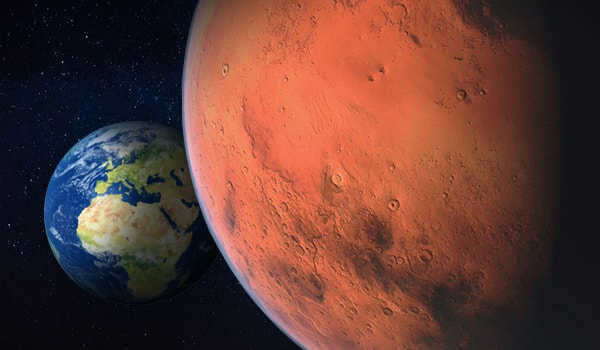
Observing Earth from Mars
Due to the spherical orbit of Mars and its center not aligning with the position of the Sun, the distance between Earth and Mars can vary significantly. This means that Mars can either approach or move away from Earth. However, during its closest proximity, Mars offers an incredible opportunity for observing our planet.
The Earth is one of the inner planets in our solar system and is constantly in close proximity to the Sun. As a result, it experiences phases similar to the Moon and other inner planets. Interestingly, the Earth is particularly captivating to observe during the periods of morning and evening twilight. Even from a distance of 154 million miles on Mars, our planet can still be located and appears to shine with a stellar magnitude of 1.4, making it almost as bright as Sirius, the brightest star in the sky. When viewed from Mars, the Earth, accompanied by the Moon, appears like a double star, with the Moon exhibiting a slightly dimmer hue. To the naked eye, our planet would emit a pale color reminiscent of seawater.
In 2003, the Express probe managed to capture an image of both the Earth and the Moon during a simultaneous encounter.
In 2004, the Spirit rover accomplished a remarkable feat by capturing an unfiltered image. Scientists were able to capture photographs that depict our planet as the most radiant star in the nocturnal expanse.
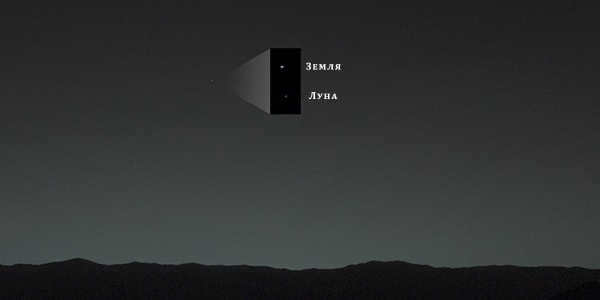
Scientists have also unveiled pictures that depict our planet and the Moon against the backdrop of the Martian night sky. At that particular moment, the average distance between Earth and Mars stood at approximately 150 million kilometers.
“If a person with excellent eyesight were to find themselves on Mars, they would be able to observe the Earth and the Moon shining brightly as evening stars,” commented NASA representatives, providing additional insight into the image. They also emphasized that aside from some minor adjustments to account for the effects of cosmic rays, the photographs have not been edited using any software programs.
Up to now, scientists studying outer space have accumulated a vast collection of photographs showcasing our planet from various vantage points across the universe. Each image serves as a poignant reminder of the insignificance of our planet in the grand scheme of galactic space and emphasizes the importance of preserving it for future generations.
Other Spectacles Visible from Mars
One fascinating sight that can be observed from Mars is the arrangement of celestial bodies as they appear from the surface of Earth. Take, for example, the view of the Milky Way from Mars. The sheer magnitude of the Milky Way is so immense that the distance between Earth and the Red Planet pales in comparison. Consequently, if humanity were to gaze upon the Milky Way from either Earth or Mars in the future, the observer would be hard-pressed to discern any noticeable distinctions.
According to images captured by the Mars Surveyor satellite (orbiting Mars) in 2003, it was revealed that our planet is more luminous compared to the view of Mars from Earth.
Furthermore, individuals standing on the surface of Mars have the opportunity to observe its two primary moons, Phobos and Deimos.
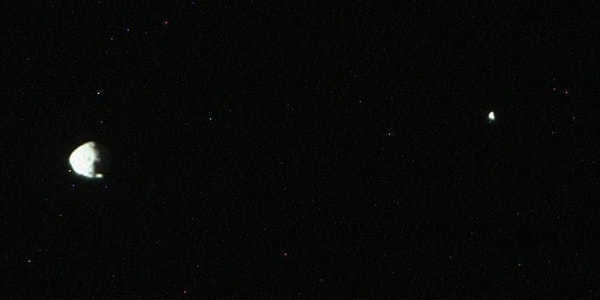
Phobos orbits Mars at a rapid pace, completing three rotations in just one day. A photograph of Phobos was captured by NASA’s Space Orbiter, taken from a distance of approximately 6,800 kilometers (about 4,200 miles).
The image captured by NASA reveals that Deimos’ surface is primarily composed of recent impact craters.
The sight of Phobos and Deimos from Mars is truly breathtaking, as these Martian satellites have the ability to partially obscure the Sun. However, neither satellite is capable of completely covering the solar disk, making the event a transit rather than a full eclipse.
In the field of astronomy, a transit refers to the movement of one celestial object passing in front of another, with the potential for some degree of overlap.
The perspective from Mars also includes a view of the Sun, separated by a distance of approximately 142 million miles. Due to Mars being one and a half times farther from the Sun compared to Earth, the Sun appears smaller in the hazy Martian sky.
On Mars, the Sun is only visible at 5/8 of its size in Earth’s sky. Additionally, Mars receives 60% less sunlight compared to Earth, resulting in a brightness similar to a cloudy day on our planet.
When observing Jupiter from Mars, it appears equally bright as it does from Earth due to its high reflectivity (albedo). Although Jupiter may seem slightly larger in the Martian sky, it still resembles a “star” point of light and does not appear as a visible disk to the naked eye.
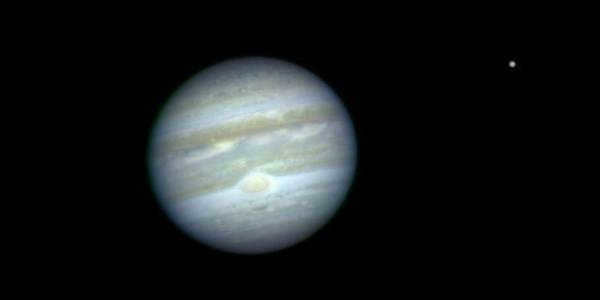
Venus appears to be the most radiant among all the planets visible from Mars in the solar system. It reflects more than 70% of the light that reaches its surface.
Mercury has a stellar magnitude of 0.35m and offers the same view as it does from Earth. However, due to its close proximity to the Sun, it is even more challenging to spot.
When compared to their appearance from Earth, the outer planets (Jupiter, Saturn, Uranus, and Neptune) will appear dimmer during their close approach to Mars. However, during opposition, they will exhibit a bright coloration. This phenomenon is particularly noticeable with Jupiter and is caused by the larger orbit of Mars in comparison to Earth, resulting in variations in the distances between the planets.
To summarize, Venus is the most luminous celestial body when observed from Mars. Earth is in third position after Jupiter because Venus reflects more light than our planet.
Did you find the information helpful? Share it on social media!
This page offers details on Jupiter’s present and projected position in the solar system and sky, taking into account your location. It also provides information on its apparent brightness, size, luminosity, and more.
Current Position of Jupiter in the Sky
The following chart displays the altitude of Jupiter above the horizon ( -, ° ) at different times of the day. The shaded areas ( ) represent the period of darkness, while the dotted line ( — ) indicates the current time.
Recent Updates on Jupiter
Astronomers have made an exciting discovery, finding water in the atmosphere of the largest satellite within our Solar System.
The longstanding mystery surrounding Jupiter’s X-ray glow has finally been unraveled, revealing its source.
Scientists have detected the most powerful winds in the stratosphere located at Jupiter’s poles.
New research suggests that the extinction of dinosaurs was caused by a comet fragment, rather than an asteroid.
An explanation for Saturn’s tilted rotation axis has been linked to Titan’s migration.
An upcoming event to look forward to is the conjunction of Jupiter and Saturn, set to occur on December 21.
Planetologists have discovered that Jupiter’s moon Europa has the ability to emit its own glow in the dark.
Unexpected phenomena await the mission to Jupiter, including small lightning, hail made of water and ammonia, and various other surprises.
According to NASA planetologists, there is a possibility that the ocean on Jupiter’s satellite could provide the necessary conditions to support life.
The current position of Jupiter in the solar system
Displayed in the diagram are the present locations of Jupiter, Earth, and the Sun, as well as their projected positions six months from now.
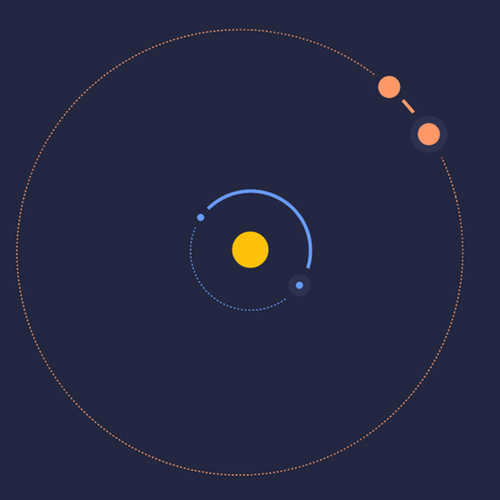
The present-day measurement of the distance from the Sun to Jupiter is available.
The current measurement of the distance from Earth to Jupiter is also available.
The animation showcases the movement of a photon from Earth to Jupiter, traveling at a speed of 299 792 458 meters per second. It will cover the current distance of 600.4 million kilometers in 33 minutes and 23 seconds.
Visibility of Jupiter in the sky for the upcoming six months
The chart displays the fluctuation in the total hours per day (h) that Jupiter is visible in the sky on a specific day, both before sunrise and after sunset.
Brightness of Jupiter in the sky over the next six months
The graph illustrates the variation in Jupiter’s brightness (-) as it correlates with the stellar magnitude (m).
Details About Other Planets in the Solar System
© 2015-2021 In-Space. All rights reserved.
Reproduction of all written content in its original form is only allowed with an active hyperlink to the In-Space publication. The audiovisual content belongs to its respective authors and copyright holders and is solely used for educational and informational purposes.
The In-Space online edition is officially registered with the Federal Service for Supervision in the Sphere of Communications, Information Technologies and Mass Communications (Roskomnadzor) since May 04, 2018. Registration certificate El No. FS 77-72684.
The website may contain material that is not suitable for individuals under 18 years old.
Which planets are visible without a telescope?
Where to locate Venus, Mars, Jupiter, and Saturn in the night sky
Jürgen Teichmann, a retired professor of physics, spent over 30 years overseeing the physics education and advanced training department at the Deutsches Museum in Munich. During his time there, he curated the largest astronomy exhibit in the world.
Gazing at the starry night sky is a captivating pastime, especially on clear summer evenings. It’s particularly enjoyable in areas with minimal light pollution, away from urban centers. We have previously shared tips on finding constellations and observing the Moon. Today, we will discuss how to spot the planets of our solar system using only the naked eye.

There are five stars in the night sky that can be observed without the aid of a telescope, and they possess distinct characteristics that set them apart from the multitude of other stars. These celestial bodies were recognized and named by ancient civilizations such as the Babylonians, Egyptians, and Greeks. The term “planet,” derived from the Greek word for “wanderer,” accurately describes these celestial travelers.
Unlike fixed stars, planets do not maintain a consistent position in the night sky. Instead, these wanderers traverse through various constellations over the course of weeks or months. While planets do not twinkle like stars, they do emit a bright and luminous glow at certain times. The five planets that are well-known to us are Mercury, Venus, Mars, Jupiter, and Saturn.
Planets do not generate their own light, unlike the Sun; instead, they merely reflect the Sun’s light. Imagine shining a lamp onto a piece of white paper in a dark room. Planets orbit around the Sun, some in close proximity (such as Mercury) and others in more distant orbits (like Uranus and Neptune). Consequently, Uranus and Neptune can only be observed using binoculars or a telescope.
Our planet, Earth, is also classified as a planet. It completes a full revolution around the Sun within a year. The ancient Greeks were unaware of this fact since Earth cannot be seen from an external perspective. All they observed was the daily movement of the stars and the Sun revolving around the Earth.
In the sky, the Greeks observed a total of five planets. It wasn’t until Copernicus that the understanding of the world changed, revealing that Earth is also a planet. Subsequently, scientists utilized the telescope to uncover two additional planets, resulting in a total of eight planets in the solar system.

How can you locate planets in the sky?
There exists a poem: “We all know: Julie’s mom sat down in the morning on pills.” This poem contains nine words, with the first letter of each word representing the name of a planet: Mercury, Venus, Earth, Mars, Jupiter, Saturn, Uranus, Neptune, Pluto. However, Pluto is now classified as a dwarf planet.
Finding Mercury in the sky can be quite challenging. It is situated too close to the Sun, so it can only be observed shortly after sunset and before sunrise. However, if your view is obstructed by mountains, trees, or buildings, it may be even more difficult to spot. In Roman and Greek mythology, Mercury (known as Hermes in Greek) was considered the messenger of the gods because it orbits the Sun faster than any other planet.
How to Spot Venus in the Sky
Let’s begin with Venus. Its orbit is situated between the orbits of Earth and Mercury, being closer to the Sun than Earth but farther away than Mercury. If you gaze towards the west just after sunset, you can catch a glimpse of Venus. At this time, the sky is still quite bright and no other stars are visible yet.
Venus shines with a brilliance that surpasses even Sirius, the brightest fixed star. On some occasions, people walking with me in the evening from the subway heading west were skeptical that the radiant light before them was actually a star. They mistook it for an airplane or an artificial satellite. Venus descends slowly towards the horizon and eventually disappears behind it a few hours after sunset.
This celestial body can be observed during the early hours of the day, before the sun has fully risen, as well as in the late hours of the evening, just after the sun has set. That is why it is often referred to as the morning or evening star. If you have previously spotted Venus in the evening, chances are you will be able to see it again the following day, shortly after sunset. This is known as Venus’ evening visibility period.
However, if Venus is no longer visible in the evening, it indicates that its evening visibility period has come to an end. It will reappear in the evening sky after a span of 19 months. If you are unwilling to wait for 19 months, you can try searching for Venus in the morning sky.
After sunset, Venus periodically disappears and then reappears in the east before the sun rises. However, the ancient Greeks were skeptical about the idea that Venus revolved around the sun. It was only through the observations of Galileo Galilei, who used his telescope, that it was proven. He noticed that Venus was illuminated by the sun from different angles, which indicated that it was orbiting the sun.
Venus is undeniably the most radiant and captivating celestial object in the sky. Its extraordinary brilliance led to its name being derived from the ancient Roman goddess of beauty and love, Venus. The Greeks, on the other hand, referred to it as Aphrodite.

Is Mars visible?
Mars can also be observed in the sky, sometimes remaining visible throughout the entire night. The reason for this is that Mars is located further from the Sun compared to our Earth. This distinction determines when we can see planets in the sky: those that are closer to the Sun than Earth are only visible in the evening or morning, while the planets that are further from the Sun can be observed all night long.
There is a specific day when Mars is visible throughout the entire night and reaches its highest point above the horizon precisely at midnight. This phenomenon is known as Mars being in opposition. During this alignment, the Sun, Earth, and Mars are in a straight line, with Earth positioned between the Sun and Mars. In this configuration, Mars is the closest to Earth and is fully illuminated by the Sun.
This is the reason why Mars appears exceptionally brilliant during these moments. If, at the onset of night, positioned high in the atmosphere where the sun was situated during the day, you observe a reddish luminous celestial body that lacks the characteristic flickering or sparkling, but instead emits a steady radiance, you can be certain that it is Mars, the deity associated with warfare in Roman mythology. In Greek mythology, he was referred to as Ares. The color red was symbolic of blood and oxidized iron. Iron was utilized in the production of weapons for combat.
Incidentally, Mars is the sole observable planet that possesses a distinctive hue. It remains clearly visible in the nocturnal sky for extended periods of time. In certain years, it exhibits an exceptionally bright luminosity, although it never reaches the level of Venus’ brilliance.
Guide to Locating Jupiter and Saturn in the Night Sky
Jupiter, known as Zeus by the Greeks, shines brighter than Mars but not as bright as Venus. On a moonless night, it stands out as the most luminous celestial body. Spotting Jupiter is a breeze and can be done throughout many months of the year. Its path through the night sky mirrors the journey of the Sun during the day. Once every 13 months, Jupiter reaches opposition with the Sun, resulting in an exceptionally radiant display. Can you recall when Mars exhibits a similar phenomenon?
Saturn, named after the ancient Roman god of agriculture, was referred to as Cronus by the Greeks. As the second most powerful deity and the father of Zeus, Cronus devoured all his offspring out of fear that they would usurp his authority. Only Zeus, also known as Jupiter, was saved by his mother and eventually overthrew his father.
It is likely that you hold the belief that the Greeks possess a collection of brutal narratives. I also share this viewpoint. In the celestial realm, Saturn is a luminous celestial body that does not radiate as intensely as Jupiter, yet it consistently captivates observers. It remains observable in the night sky for a duration of several months annually. Saturn will become visible in the nocturnal expanse in July 2020, and subsequently it will not reappear until the passage of 12.5 months. Regrettably, the extraordinary rings encircling Saturn are solely discernible via employment of a telescope.
Why do stars shimmer while planets remain steady?
In reality, the fixed stars themselves do not shimmer or glisten. Astronauts in space observe the stars shining calmly. The atmosphere surrounding our Earth is responsible for the twinkling of the stars. It is as if the air is constantly trembling ever so slightly. This phenomenon is most noticeable on hot summer days when you gaze out the window. At that moment, it appears as if the air is vibrating and something small (like trees) is radiating on the horizon. And stars appear as minuscule specks in the sky because they are incredibly far away, causing the air to “twitch” them.
If you observe the planets through a telescope, you will notice that they are not specks but rather small circles. The light emitted from one section of such a circle does not shimmer or flicker, whereas the light from another section “shakes.”
Observing Jupiter: A Guide

A Brief Overview
Jupiter, the largest planet in our solar system, is approximately 11.2 times the size of Earth and has a mass that is 318 times greater. Unlike Earth, Jupiter does not have a solid surface, as it is classified as a gas giant mainly composed of hydrogen and helium.
The planet was named after Jupiter, the main god in ancient Roman mythology, while the Greeks referred to it as Zeus. Interestingly, Jupiter does not experience seasons like Earth due to its equatorial plane being inclined at only 3 degrees to its orbit plane. Similar to Saturn, Jupiter also possesses a system of faint rings, although these cannot be observed with amateur telescopes. Currently, there are 63 known satellites orbiting the planet.
What is the best time to observe Jupiter?
Jupiter is one of the most easily visible planets and is second only to the Sun, Moon, and Venus in terms of brightness. The optimal time to observe Jupiter is during opposition, which happens once a year and is when the planet is closest to Earth. The date of opposition shifts by about a month each year (see Table 1). During summer oppositions, Jupiter does not rise very high above the horizon, typically reaching only 20-30 degrees for observers in Russia. Therefore, the best periods for observing Jupiter are during winter oppositions when the planet is visible high in the sky all night long. If you can brave the winter cold, you’ll have the opportunity to witness Jupiter completing a full rotation on its axis in just one night.
Table #1: Closest oppositions of Jupiter
SSH – South Polar Cap SPS – North polar cap SSH – South-South Temperate Belt SSM – Southern temperate belt BKP – Great Red Spot SEP – Southern Equatorial Belt ES – Equatorial Belt NEP – Northern Equatorial Belt NEP – Northern Temperate Belt NMSP – North North Temperate Belt SSUS – South-South Temperate Zone SSUZ – Southern temperate zone SUTZ – Southern tropical zone EZ – Equatorial zone NTZ – Northern tropical zone NTR – Northern temperate zone SSAS – Northern Temperate Zone
The subsequent step in familiarizing oneself with Jupiter is to examine the intricate aspects of the atmospheric structure. Several of these can only be observed using large amateur telescopes, necessitating optimal observing conditions and strong observational abilities.
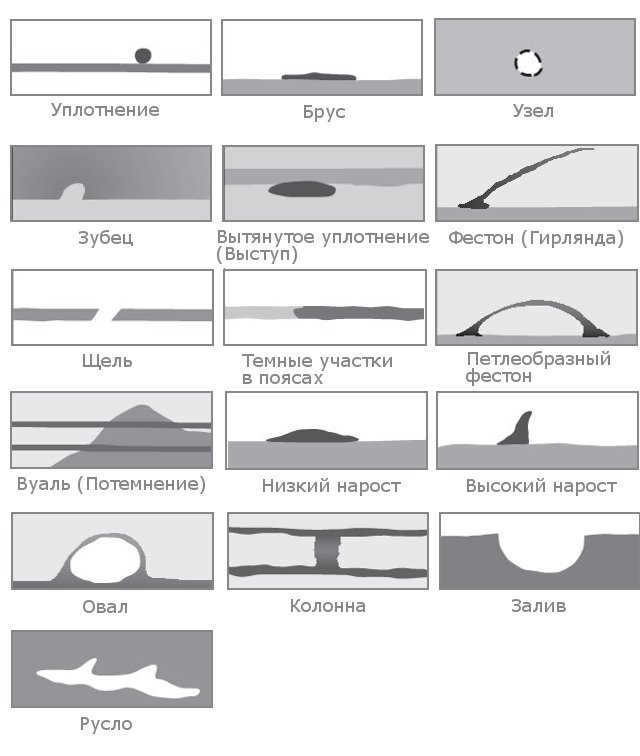
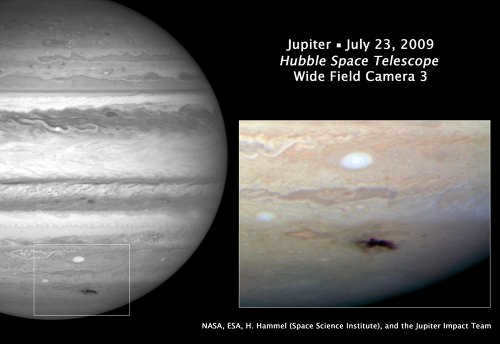
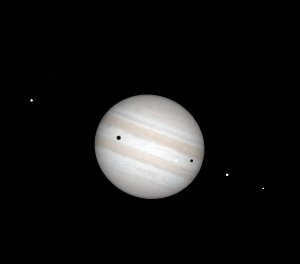
It is important to mention that when we observe the shadows of the satellites on Jupiter’s surface, we are actually witnessing a solar eclipse occurring on the planet. This is similar to how we would perceive a solar eclipse on Earth if we were viewing our planet from outer space.
Satellites crossing the background of the planet Another fascinating yet challenging task is observing the passage of satellites across the disk of Jupiter. The difficulty lies in the fact that the satellites have little contrast against the bright disk of the planet. To observe the satellites against the backdrop of Jupiter’s clouds, a large telescope, clear and calm atmosphere, and knowledge of the following are required: 1. Satellites are more visible when they are near the edge of the disk. 2. The contrast also depends on whether the satellite passes against the dark belts or bright zones of the planet.
Ice-covered Europa reflects 68% of the sunlight it receives, making it the only satellite brighter than Jupiter’s clouds. Callisto is the darkest, reflecting only 19% and appearing darker than the clouds. Io has a yellowish tint, while Ganymede almost blends into the background, although it is larger in size.
During oppositions, it is possible to observe the simultaneous passage of a satellite and its shadow across Jupiter’s disk.
Eclipses and coverings As satellites orbit Jupiter, they periodically fall into its shadow and disappear from view. This phenomenon is known as an eclipse. When entering the shadow, the satellites do not vanish all at once. Io and Europa disappear quickly, while Ganymede and Callisto gradually fade away. It is also fascinating to observe the satellite emerging from the shadow. However, pinpointing the exact moment of the satellite’s appearance is quite challenging. When a satellite enters the shadow, the observer sees it becoming dimmer until it completely disappears. On the other hand, the process of the satellite exiting the shadow is the opposite. One must look at the anticipated location of the satellite’s emergence, which makes it easy to miss the moment when it begins to brighten up. This phenomenon is also called an overlap. We can identify two phases of the satellite’s coverage by Jupiter: the moment when it goes behind the planet’s disk and the moment when it reappears. In the first case, it is interesting to observe the merging of the satellite with the planet, creating the impression of the satellite being slowly absorbed by Jupiter. In the second case, the satellite first appears as a small protrusion, then elongates and separates from the planet, resembling a drop forming on a leaky water faucet. Mutual eclipses and satellite coverings The rarest phenomena in Jupiter’s satellite system are mutual coverings and eclipses. Approximately once every 6 years (to be more precise, once every 5.93 years), a series of coverings of one satellite by another occurs over several months. These coverings are relatively easy to observe as the satellites approach each other in the telescope, merge, and form an elongated blob, as depicted in the figure below.


Author Roman Bakay. 2009
Jupiter, the largest planet in the Solar System, is positioned as the fifth planet in terms of distance from the Sun. Similar to Uranus, Neptune, and Saturn, Jupiter is categorized as a gas giant. Its existence has been acknowledged by humanity for a substantial period of time. Frequent allusions to Jupiter can be found within religious doctrines and mythologies. In contemporary society, the planet was named after the revered ancient Roman deity.
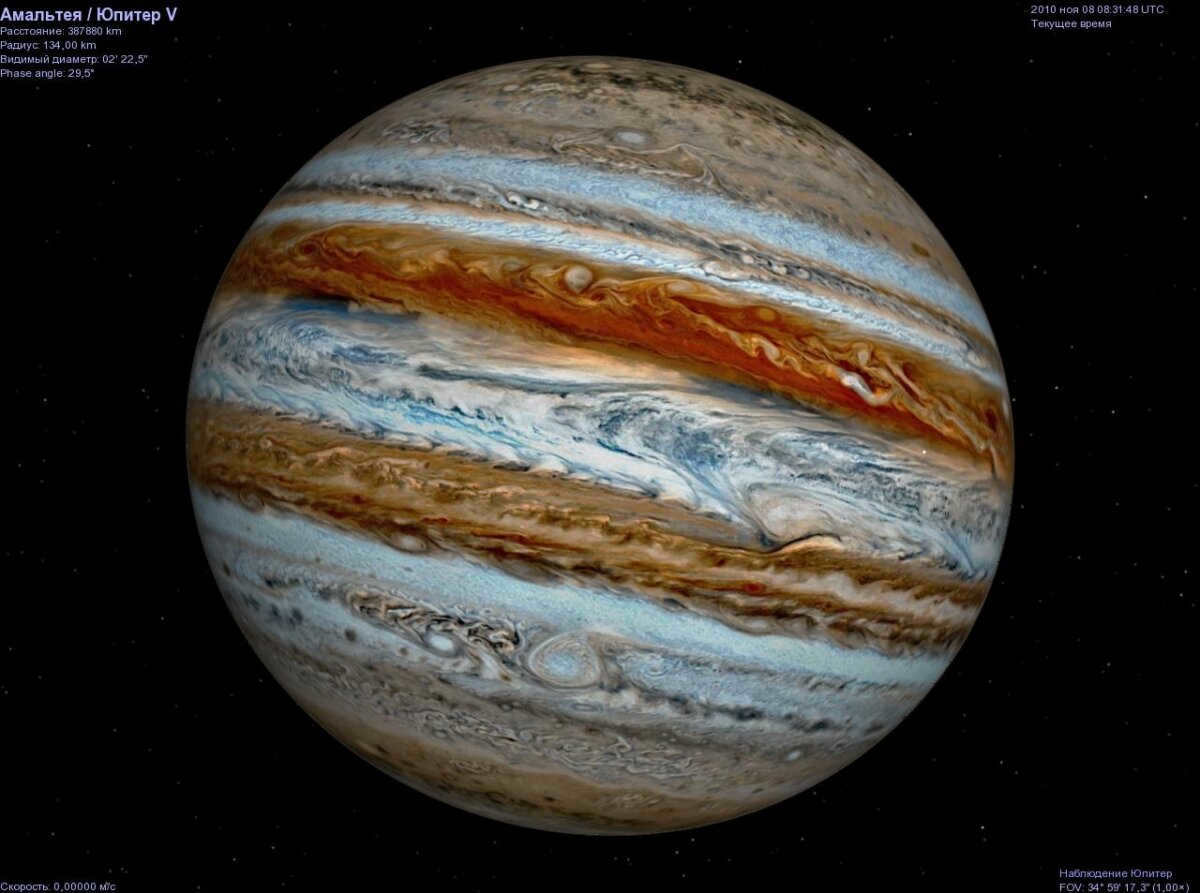
The atmospheric events on Jupiter are significantly larger in scale compared to those on Earth. One of the most remarkable features on the planet is the Great Red Spot, a massive storm that has been known to astronomers since the 17th century.
Jupiter boasts a total of 67 satellites, with some of the largest ones being Europa, Io, Callisto, and Ganymede. These moons were initially observed by G. Galileo in 1610.
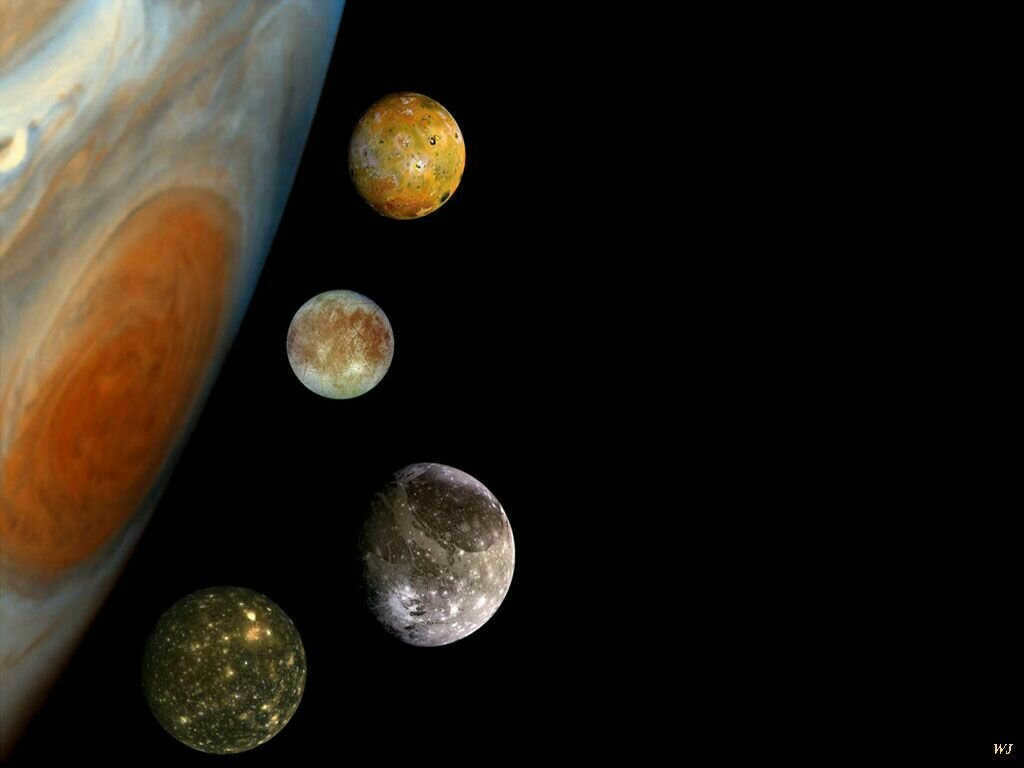
The exploration of Jupiter relies on the use of telescopes located both in space and on the ground. Over the past few decades, NASA has launched a total of 8 missions to study this magnificent planet. During specific astronomical events known as great oppositions, Jupiter can be seen without the aid of any optical devices. In fact, it is one of the brightest objects in the night sky, surpassed only by Venus and the Moon. Given its fascinating system of moons and its distinctive disk, Jupiter is a favorite target for both amateur and professional astronomers alike.
Observations of Jupiter
Optical range
If you examine the object in the infrared region of the electromagnetic spectrum, you can observe the presence of Ne and H2 molecules, as well as the visibility of lines from other elements. The quantity of H can provide insights into the planet’s origin, while the qualitative and quantitative composition of other elements can reveal information about its internal evolution. However, helium and hydrogen molecules lack a dipole moment, meaning their absorption lines are not visible until impacted by ionization. Furthermore, these lines only appear in the upper layers of the atmosphere, limiting their ability to provide data about deeper layers. Therefore, the most reliable information regarding the amount of hydrogen and helium on Jupiter can be obtained through the use of the Galileo instrument.
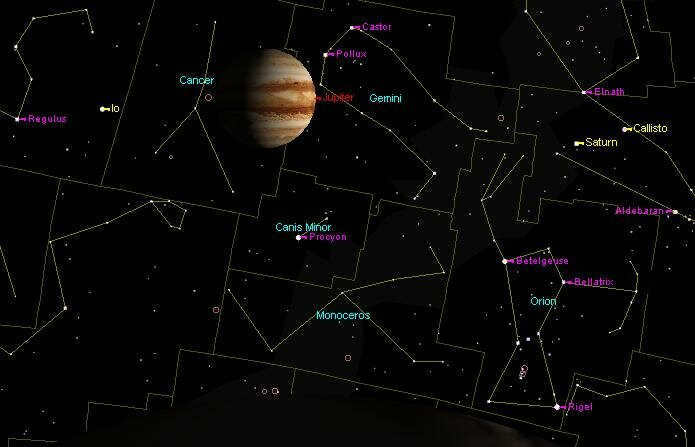
When it comes to the other elements, their analysis and interpretation present significant challenges. It is difficult to ascertain the exact processes occurring in Jupiter’s atmosphere, and the chemical composition remains a topic of great controversy. However, most astronomers believe that any processes affecting the elements are localized and limited in their impact. Therefore, they do not cause significant changes in the distribution of substances.
Jupiter emits 60% more energy than it receives from the Sun. These processes have an effect on the planet’s size, as Jupiter is shrinking by 2 centimeters per year. In 1974, P. Bodenheimer proposed the idea that during its formation, Jupiter was twice its current size and had a much higher temperature.
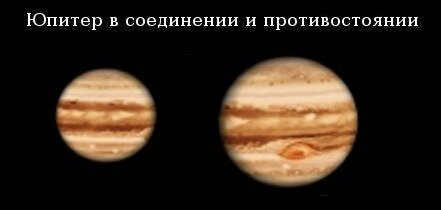
Gamma-ray
Research into Jupiter’s gamma radiation focuses on the northern lights and the planet’s disk. In 1979, the Einstein Space Laboratory discovered this phenomenon. While the polar aurora regions on Earth align with ultraviolet and X-rays, this is not the case for Jupiter. Previous studies found a radiation pulsation with a 40-minute cycle, but later research revealed that this correlation is not as strong as initially thought.
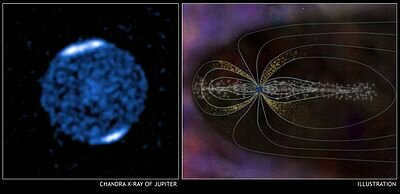
Scientists were anticipating that the aurora on Jupiter would resemble the aurora of comets when observed in the X-ray spectrum. However, these expectations were contradicted by observations made with the Chandra telescope.
According to data from the XMM-Newton Space Observatory, it appears that the emission from the disk in the gamma-ray spectrum is actually a reflection of solar X-ray radiation. Unlike the aurora borealis, there is no periodic variation in the intensity of this radiation.
Observations of Radio Waves
Jupiter is one of the most potent sources of radio waves in the solar system when it comes to frequencies in the meter to decimeter range. The radio waves emitted by Jupiter are sporadic in nature, appearing as bursts that occur between 5 to 43 MHz, with an average width of 1 MHz. These bursts are very brief, lasting only 0.1 to 1 second. The radio waves are also polarized and can reach up to 100% circular polarization.
When it comes to shorter wavelengths in the centimeter to millimeter range, Jupiter’s radio emission takes on a purely thermal nature. However, the brightness temperature of these emissions is much higher compared to the equilibrium temperature, suggesting a significant heat flux from Jupiter’s interior.
Gravitational Potential Calculations
The gravitational field of Jupiter, as observed through spacecraft trajectories and natural satellite movements, exhibits significant deviations from spherically symmetric behavior. Typically, the gravitational potential is expressed in a decomposed form using Lejandre polynomials.
The Pioneer 10, Pioneer 11, Galileo, Voyager 1, Voyager 2, and Cassini spacecraft have utilized various measurements to calculate the gravitational potential. These measurements include: 1) analyzing transmitted images to determine spacecraft location; 2) utilizing the Doppler effect; and 3) employing radio interferometry. In certain cases, the gravitational influence of the Great Red Spot had to be taken into consideration during these measurements.
Additionally, while processing the data, we must propose the theory regarding the motion of Galileo’s satellites as they orbit around the planet’s center. One significant challenge in achieving accurate calculations involves accounting for non-gravitational acceleration.
Jupiter’s Position in the Solar System
This gas giant has an equatorial radius of 71.4 thousand kilometers, which is equivalent to 11.2 times the radius of the Earth. It is worth noting that Jupiter is the only planet of its kind to have a center of mass situated outside of the Sun.
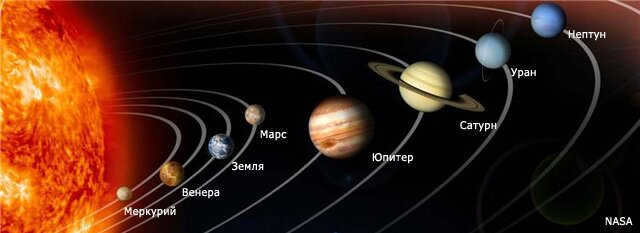
Jupiter’s mass is 2.47 times greater than the combined weight of all the planets, and it is 317.8 times greater than the mass of the Earth. However, it is less than 1000 times the mass of the Sun. In terms of density, Jupiter is very similar to the Sun and 4.16 times less dense than Earth. However, its gravitational force is 2.4 times stronger than that of Earth.
The failed star status of Jupiter.
Various research on theoretical models has indicated that if Jupiter had a slightly higher mass, it would experience a decrease in size. Although minor alterations would not impact the planet’s radius, a fourfold increase in actual mass would result in such a significant rise in planetary density that the planet would initiate the process of shrinking due to the immense gravitational pull.
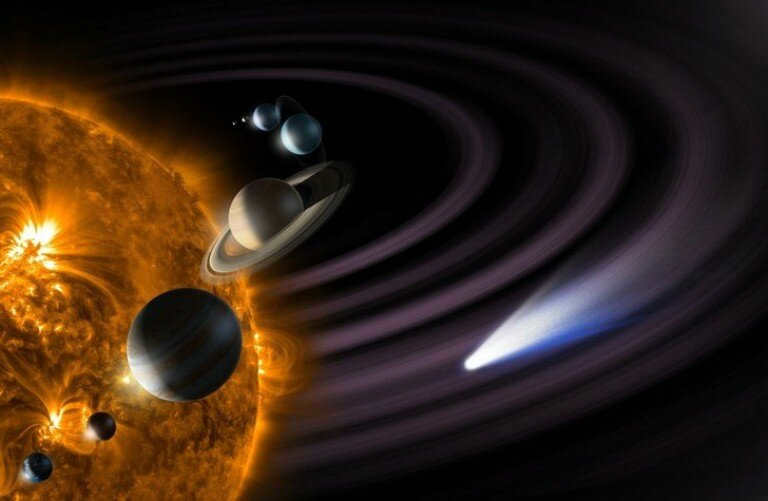
According to this research, Jupiter holds the record for the largest diameter among planets with comparable histories and structures. If its mass had increased even more, Jupiter would have undergone a prolonged contraction, eventually becoming a brown dwarf with a mass 50 times greater than its current mass during the process of star formation. Astronomers consider Jupiter to be a “failed star,” although it remains uncertain whether the process of planet formation for Jupiter shares similarities with the formation of planets in double star systems. Early data suggests that Jupiter would need to be 75 times more massive in order to become a star, but the smallest known red dwarf is only 30% larger in diameter.
Jupiter’s Revolution and Path
When observed from our planet, Jupiter shines with a magnitude of 2.94m, ranking as the third most luminous celestial body seen with the unaided eye, surpassed only by Venus and the Moon. Its size appears to be 1.61m when it is farthest away from us. The closest distance between Earth and Jupiter measures 588 million kilometers, while the farthest reaches 967 million kilometers.
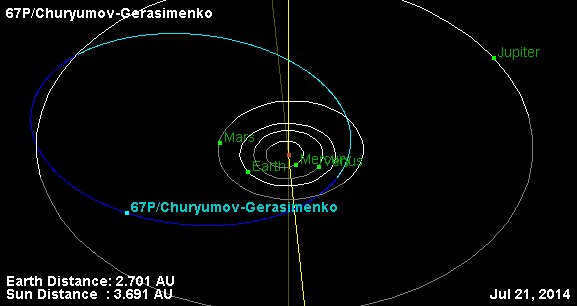
The encounter of the planets takes place approximately every 13 months. It is important to mention that once every 12 years there is a significant opposition of Jupiter, during which the planet is near the perihelion of its own orbit, and its apparent size from Earth reaches 50 angular seconds.
Jupiter is located 778.5 million kilometers away from the Sun, and it completes a full orbit around the Sun in 11.8 years, which is equivalent to approximately 11.8 Earth years. The largest disturbance to Jupiter’s orbital motion is caused by Saturn. There are two types of disturbances:
- Eternal – it remains valid for 70,000 years and leads to changes in the eccentricity of Jupiter’s orbit.
- Resonant – it occurs due to the proximity ratio of 2:5.
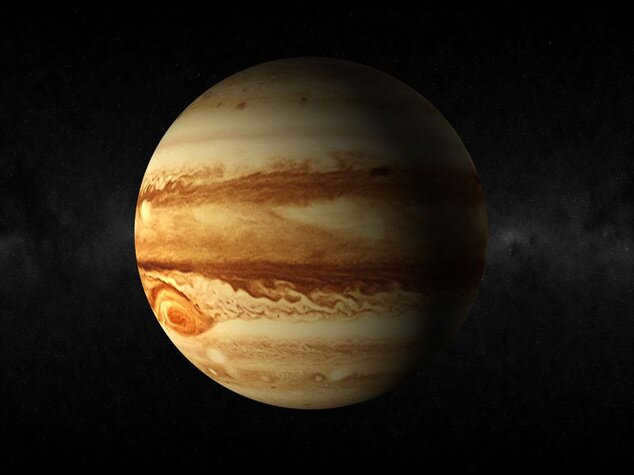
One of the unique features of Jupiter is its close proximity between the plane of its orbit and the plane of the planet itself. Unlike Earth, Jupiter does not experience seasonal changes because its axis of rotation is inclined at 3.13 degrees, whereas Earth’s axis is inclined at 23.45 degrees.
Jupiter holds the record for the fastest rotation among all the planets in the solar system. Near the equator, it completes one full rotation in just 9 hours, 50 minutes, and 30 seconds. However, at middle latitudes, this rotation takes an additional 5 minutes and 10 seconds. This rapid rotation causes the planet’s equatorial radius to be 6.5% larger than its radius at middle latitudes.
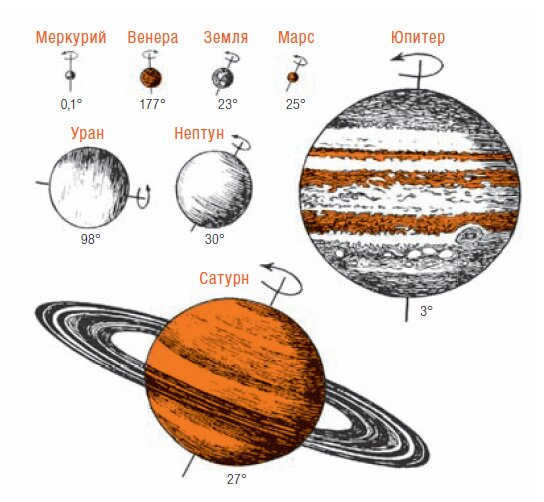
Possible Scenarios of Life Existence on Jupiter
A significant amount of research conducted over an extended period of time indicates that the conditions on Jupiter are not conducive to the origin of life. This is primarily due to the limited presence of water in the planet’s atmosphere and the lack of a solid surface. It is worth noting that in the 1970s, a theory was proposed suggesting the possible existence of living organisms in the upper layers of Jupiter’s atmosphere, which would rely on ammonia as a basis for life. Supporting this hypothesis is the fact that even at relatively shallow depths, the planet’s atmosphere maintains high temperatures and densities, which facilitate chemical evolutionary processes. This theory was put forth by Carl Sagan, and in collaboration with E.E. Solpiter, they conducted numerous calculations that led them to propose three hypothetical forms of life on the planet:
- Floters – are designed to function as massive organisms, comparable in size to a major Earth city. They bear resemblance to balloons in that their purpose is to extract helium from the atmosphere while leaving hydrogen behind. Their habitat is the upper atmosphere where they generate molecules to sustain themselves.
- Sinkers are microscopic organisms capable of rapid reproduction, enabling the species to ensure its survival.
- Hunters are carnivorous creatures that prey on floters.
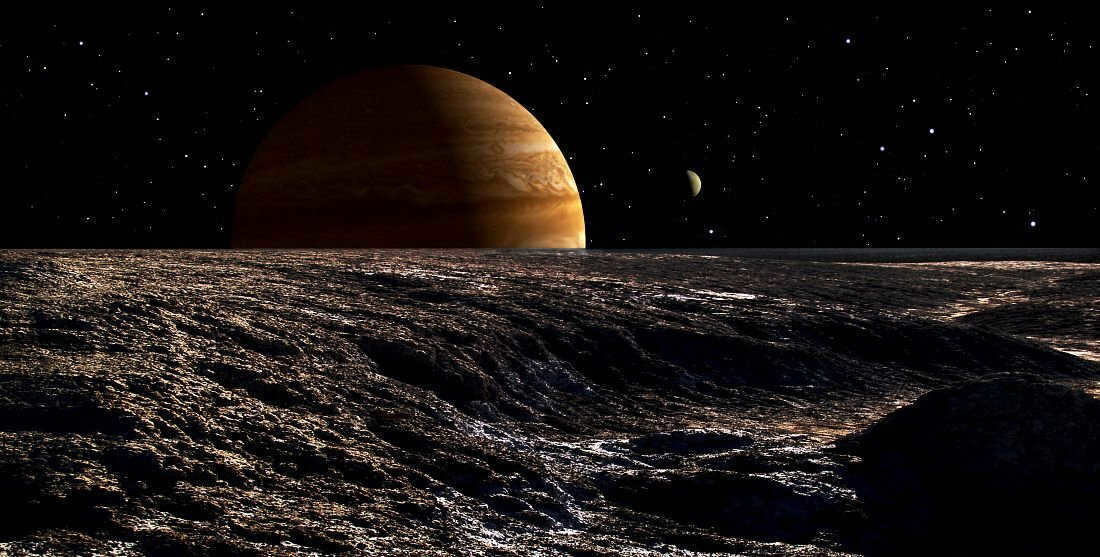
However, these explanations are mere suppositions lacking scientific confirmation.
The composition of the planet
Present-day technology does not currently permit scientists to determine the precise chemical makeup of Jupiter. Nevertheless, the upper layers of the planet’s atmosphere have been extensively examined. The study of the atmosphere was made possible through the descent of the spacecraft Galileo, which entered Jupiter’s atmosphere in December 1995. This permitted scientists to assert with accuracy that the atmosphere is comprised primarily of helium and hydrogen. Additionally, traces of methane, ammonia, water, phosphine, and hydrogen sulfide were identified. It is believed that the deeper layers of the atmosphere, specifically the troposphere, consist of sulfur, carbon, nitrogen, and oxygen.
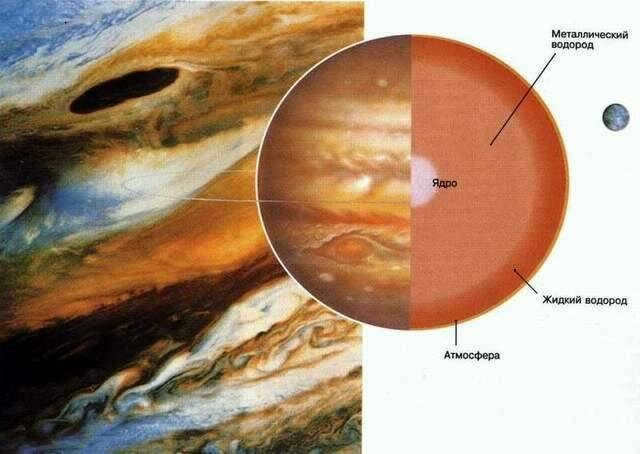
In addition to the Sun, there are also inert gases like xenon, argon, and krypton on Jupiter, but their concentration is higher. The upper atmosphere of the planet could potentially contain water, dioxide, and monoxydrugarbons as a result of comet collisions, as exemplified by comet Shoemaker-Levy 9.
The planet’s reddish hue can be attributed to the presence of red phosphorus, carbon, and sulfur compounds, or even organics that formed due to electric discharges. It is worth noting that the atmosphere’s color is not consistent throughout, indicating variations in chemical composition across different regions.
The Composition of Jupiter
Jupiter is thought to have a layered internal structure, hidden beneath its clouds. It is believed that the planet’s interior is composed of a 21-thousand-kilometer-thick layer of helium and hydrogen. In this region, the matter smoothly transitions from a gaseous to a liquid state. Below this layer lies a 50-thousand-kilometer-thick layer of metallic hydrogen. Finally, at the center of the planet, there is a solid core with a radius of 10 thousand kilometers.
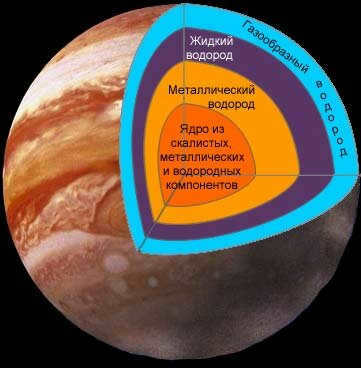
The most well-known model of Jupiter’s composition:
- Atmosphere:
- Outer layer made up of hydrogen.
- The middle layer consists of 10% helium and 90% hydrogen.
- The lower section is a mixture of helium, hydrogen, ammonium, and water. This layer is further divided into three parts:
- The top part is solid ammonia, with a temperature of -145°C and a pressure of 1 atm.
- In the middle is crystallized ammonium hydrosulfate.
- The bottom part contains solid and possibly liquid water. The temperature is around 130°C and the pressure is 1 atm.
- A metallic hydrogen layer is present, with temperatures ranging from 6.3 thousand to 21 thousand kelvin. The pressure also varies, from 200 to 4 thousand Gpa.
- A stone core is present.
This model was created by analyzing observations and conducting research, while considering the laws of extrapolation and thermodynamics. It is important to note that the boundaries between adjacent layers are not clearly defined, indicating that each layer is independent and can be studied separately.
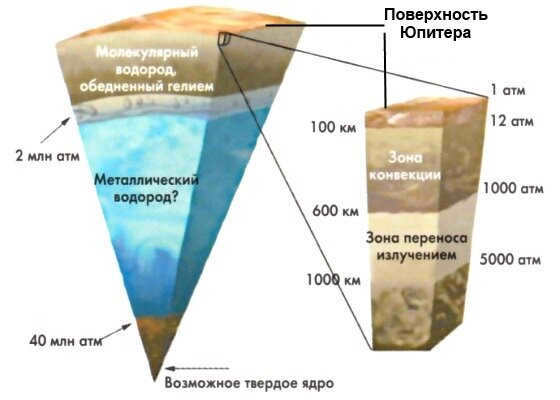
The Composition of Jupiter’s Atmosphere
The temperature distribution across Jupiter’s atmosphere is not uniform. Similar to Earth, Jupiter’s atmosphere is composed of multiple layers. The uppermost layers of the atmosphere have the highest temperatures, while the temperatures decrease significantly as you move towards the planet’s surface. However, the pressure increases in the same direction.
The thermosphere of Jupiter plays a crucial role in dissipating the planet’s heat and is also responsible for the formation of the polar lights. The upper boundary of the thermosphere is defined at a pressure level of 1 nbar. During the study, scientists obtained data on the temperature within this layer, which reached a peak of 1000 K. The exact cause of such high temperatures is still unknown to scientists.
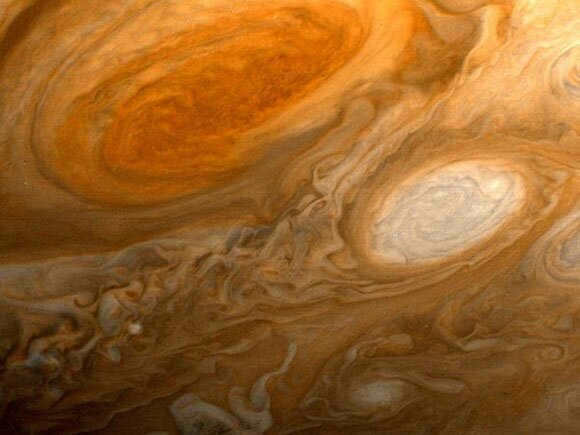
According to information obtained from the “Galileo” spacecraft, the temperature on the upper clouds of Jupiter is recorded at -107 °C under a pressure of 1 atmosphere. However, as the spacecraft descends to a depth of 146 kilometers, the temperature increases significantly to a staggering +153 °C under a pressure of 22 atmospheres.
The Future of Jupiter and its Satellites
It is common knowledge that, in the future, the Sun will deplete its thermonuclear fuel supply and its luminosity will increase by 11% every billion years, similar to other stars. As a result, the habitable zone will gradually shift beyond our planet’s orbit and eventually reach Jupiter’s surface. This shift will have the potential to melt all the water on Jupiter’s satellites, creating favorable conditions for the emergence of life forms on the planet. It is predicted that in approximately 7.5 billion years, the Sun will transform into a red giant, causing Jupiter to gain a new status as a hot Jupiter. Consequently, the planet’s surface temperature will reach around 1000 K, causing it to emit a radiant glow. In this scenario, the satellites will appear as barren wastelands, devoid of any signs of life.
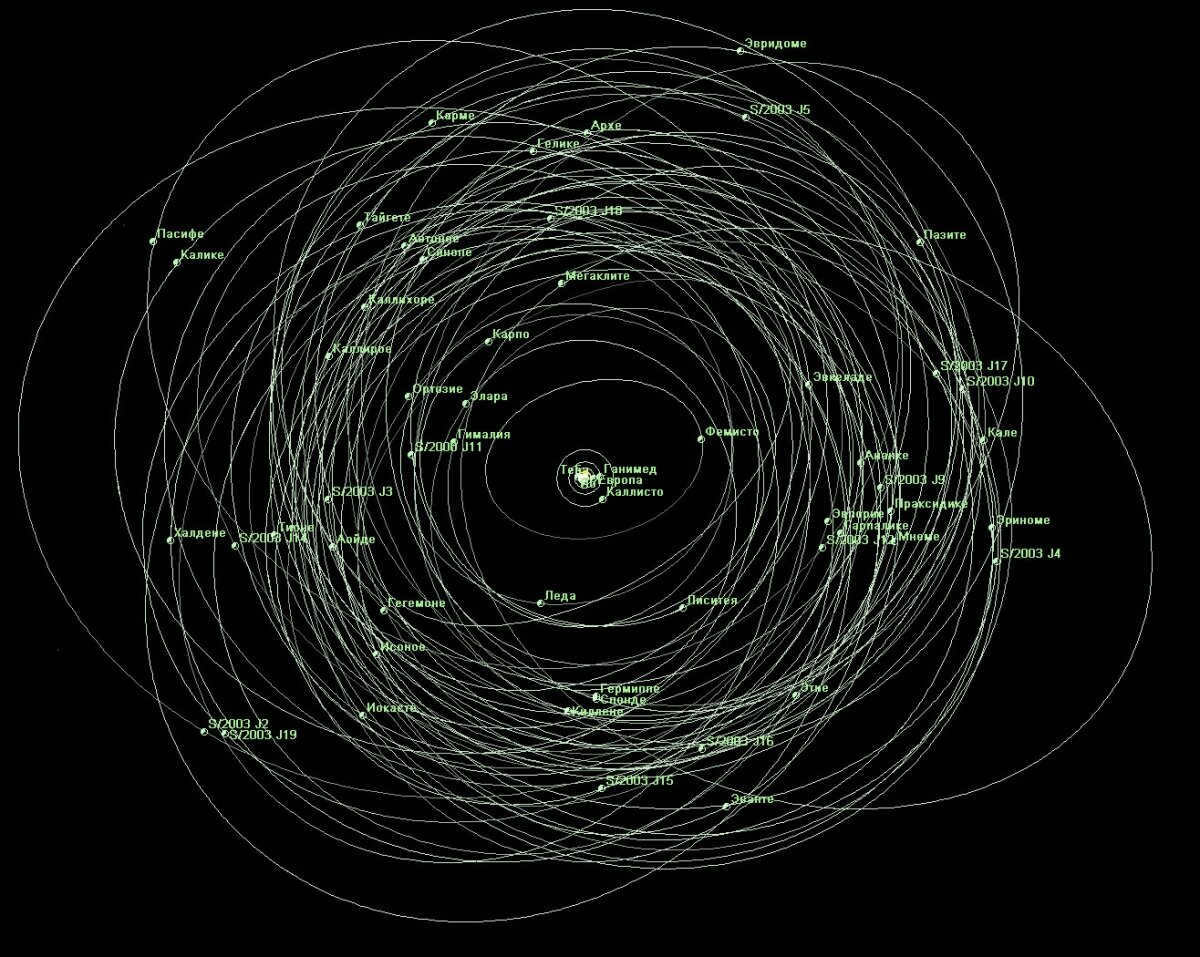
Jupiter’s Moons
According to current data, Jupiter is known to have a total of 67 natural moons. Scientists suggest that there may be even more than a hundred of these objects orbiting around Jupiter. These moons are typically named after mythical characters that have some connection to Zeus. The moons are divided into two groups: inner and outer. The inner group consists of only 8 moons, including the famous Galilean moons.

In the year 1610, the renowned scientist Galileo Galilei made an extraordinary revelation when he discovered the initial satellites of Jupiter. These satellites, namely Europa, Ganymede, Io, and Callisto, provided further validation for Copernicus and his groundbreaking heliocentric system.
